Spectroscopic and Microscopic Characterization of Inorganic and Polymer Thermoelectric Materials: A Review
Abstract
1. Introduction
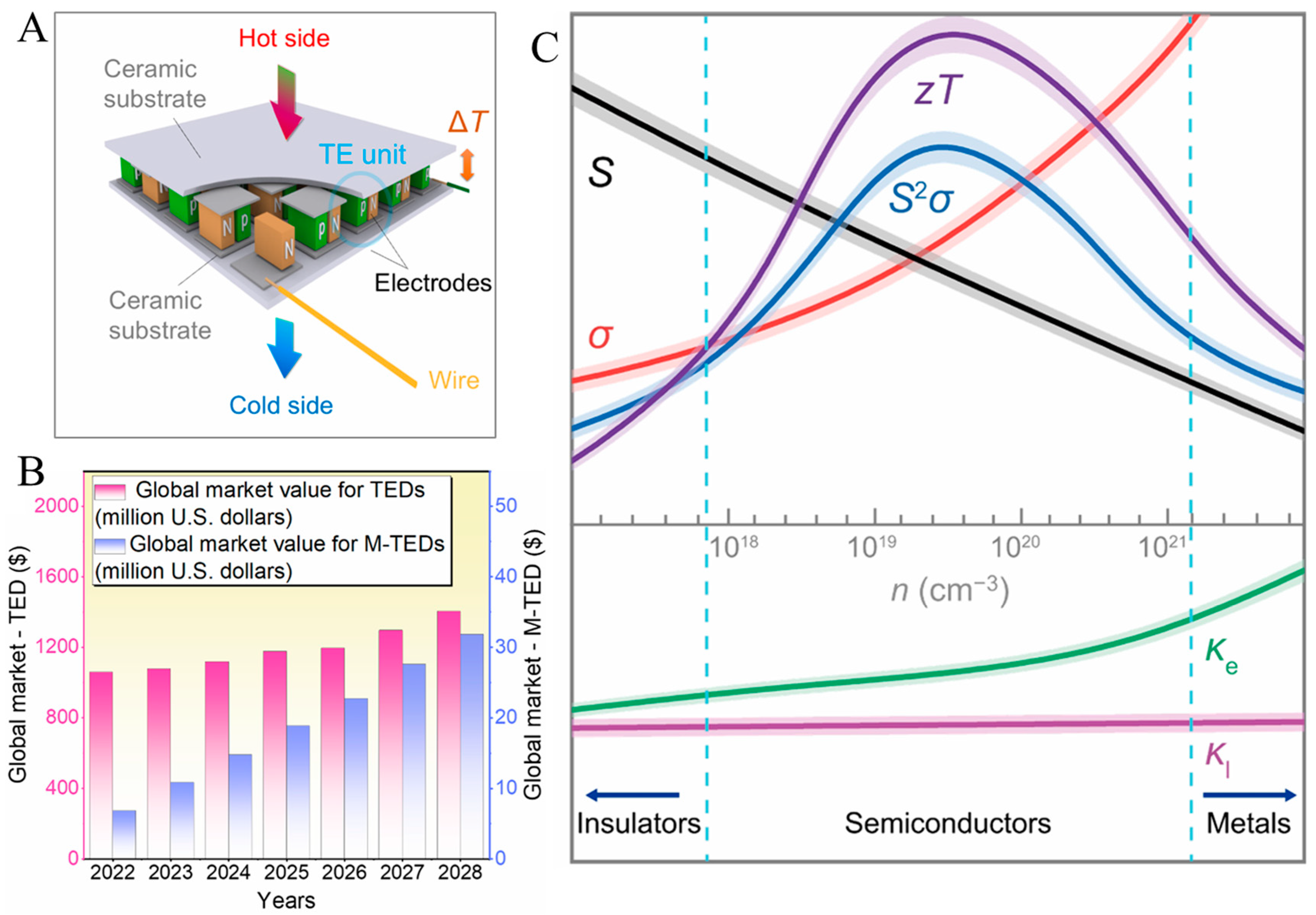
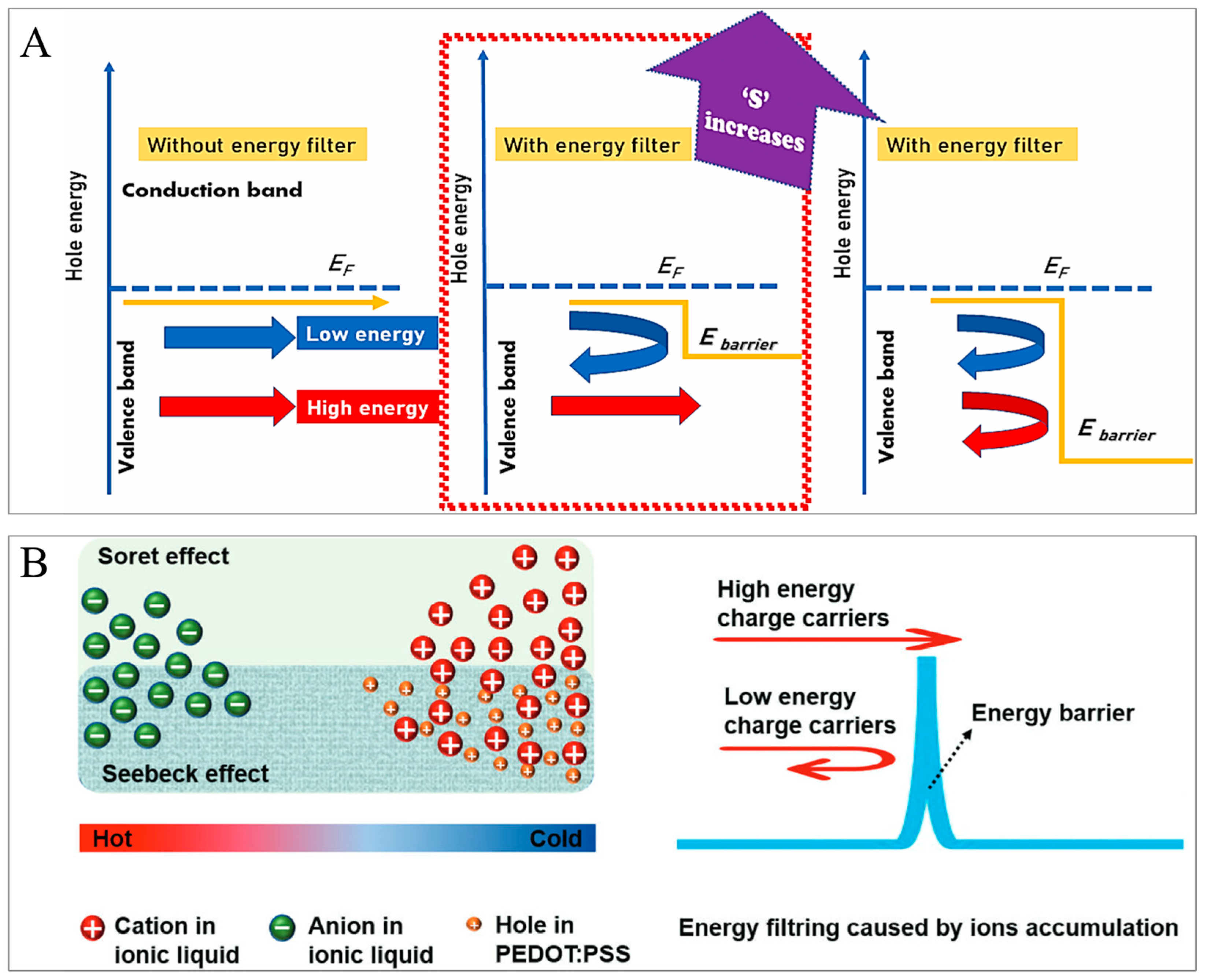
2. Spectroscopies and Microscopy Techniques of Inorganic TE Materials
2.1. Electronic Structure Characterization
2.1.1. EDX Spectroscopy
2.1.2. UV−Vis Spectroscopy
2.1.3. XPS
2.2. Phase Analysis
2.2.1. RS
2.2.2. NMR Spectroscopic
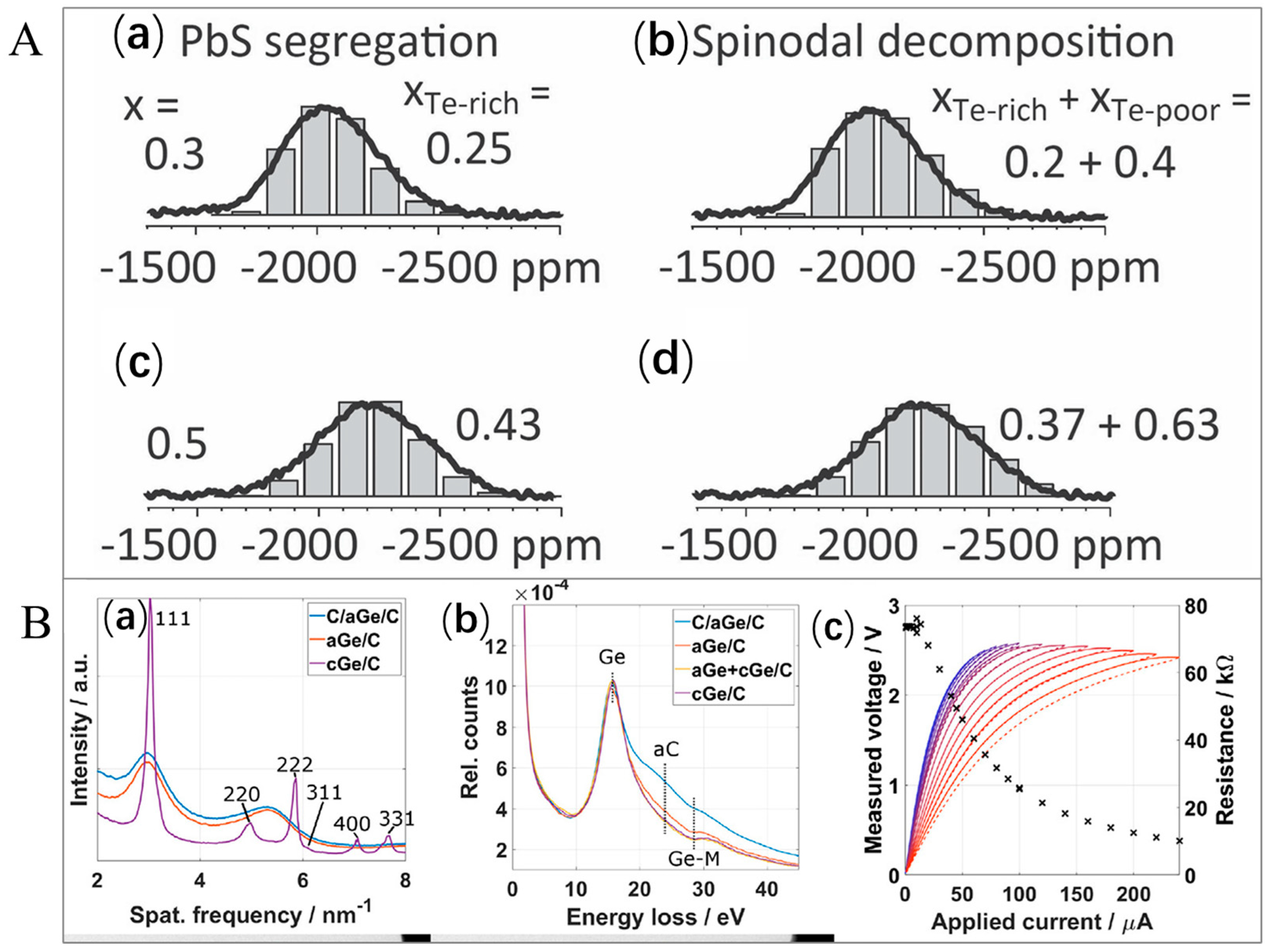
2.2.3. EELS
2.3. Surface Morphology and Crystalline Structure Analysis
2.3.1. SEM
2.3.2. TEM
2.3.3. XRD
3. Spectroscopic and Microscopic Approaches Applied to Polymer TE Materials
3.1. Electronic Structure
3.1.1. UV−Vis−NIR Spectroscopy
3.1.2. UPS
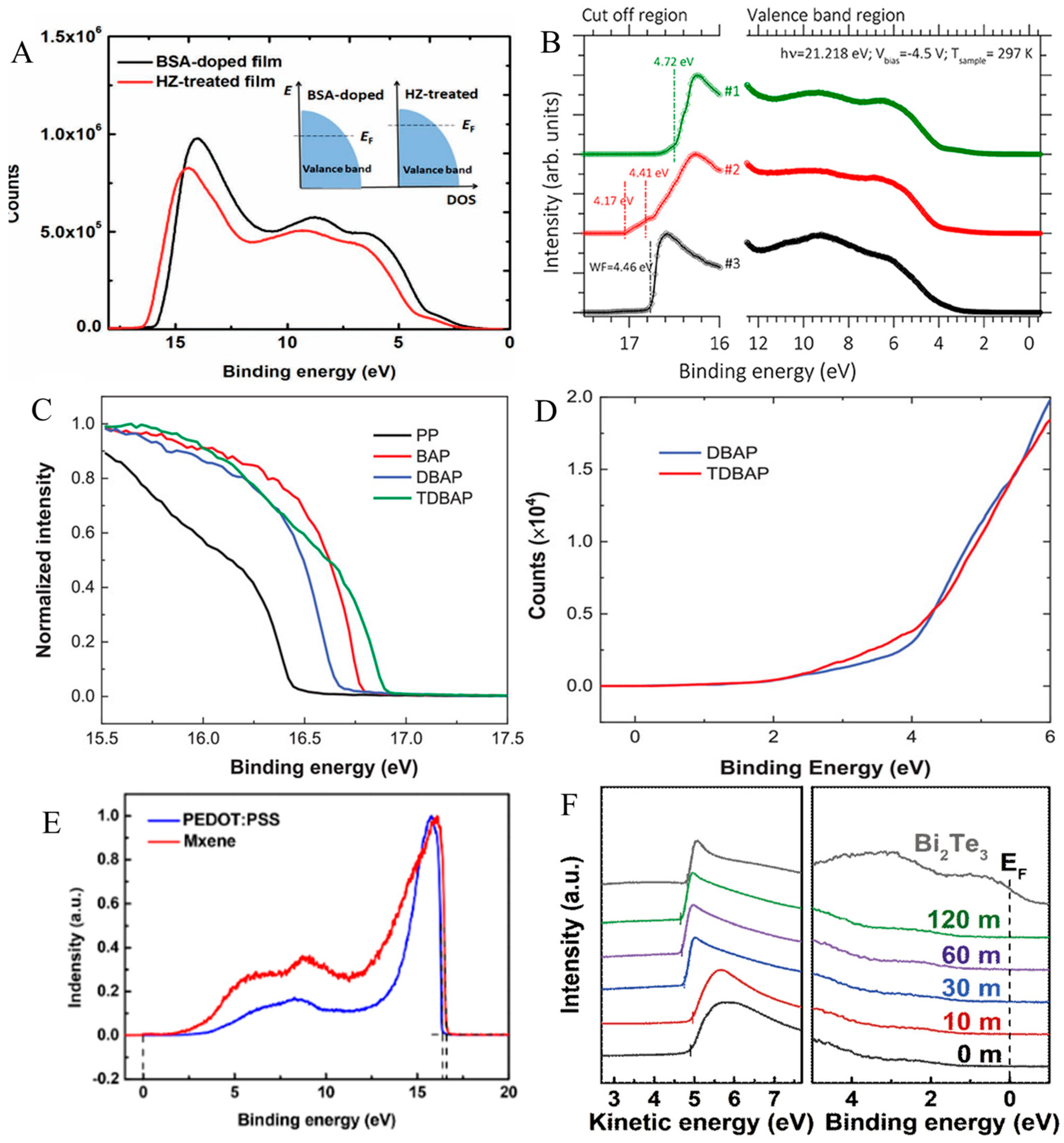
3.2. Functional Groups Analysis
3.2.1. ATR-FTIR Spectroscopy
3.2.2. RS
3.3. Elemental Composition Analysis
XPS
3.4. Surface Morphology Analysis
3.4.1. AFM
3.4.2. SEM
3.5. Crystalline Structure Analysis
3.5.1. GIWAXS
3.5.2. XRD
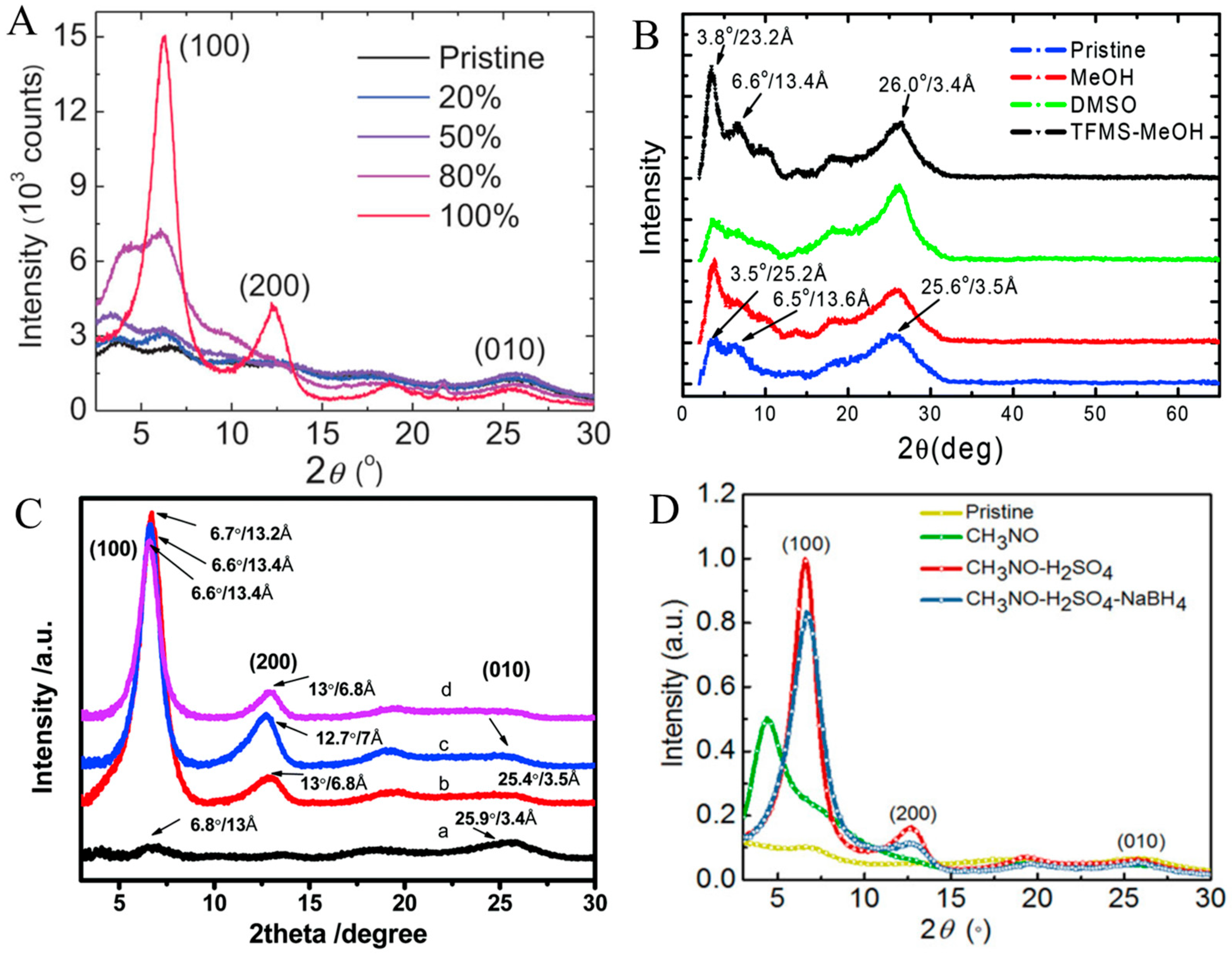
| PEDOT:PSS-Based TE Materials Through Various Post-Treatments | Characterization | Achievements | PF (μW/mK2) | σ (S/cm) | S (μV/K) | Ref. |
|---|---|---|---|---|---|---|
| Pristine (untreated) PEDOT:PSS | XPS, UPS, RS, AFM, XPS, CVs, RS, UV−Vis−NIR, and XRD | The k and ZT of pristine PEDOT:PSS were measured to be <1 W/mK and in the order of 10−6, respectively | <0.04 | <1 | 15–18 | [69,70,83,282,312,313,314,315,316] |
| Triflic acid | RS and UV-Vis-NIR | TE properties were enhanced by both σ and S simultaneously | 94 | 1686 | 23.6 | [317] |
| Tetrahedrite (TH) Cu12+xSb4S13 | SEM, RS, and AFM | The greatest TE performance/properties were attained for a pellet specimen with a ZT value of ca. 0.12 at 473 K | 0.19 | 80 | 120 | [318] |
| Cu0.98Zn0.02FeS2/PEDOT:PSS | SEM, XRD, RS, and EDX | Nontoxic, inexpensive, and abundant Zn-doped chalcopyrite (Cu1−xZnxFeS2 with x = 0.03, 0.02, and 0.01) was combined with PEDOT:PSS | 19.1 | 18.2 | −61.3 | [319] |
| Cu0.98Zn0.02FeS2/PEDOT:PSS/graphene | SEM, XRD, RS, and EDX | The optimum film preserved above 80% of the σ after bending cycles of 2000, and a five-leg TE prototype built for optimum ternary films produced 4.8 mV at ΔT = 13 °C. | ∼23.7 | 77.4 | −61.3 | [319] |
| DMSO/PEDOT:PSS/SWCNTs/NaBH4 | AFM, SEM, XPS, RS, | A home-made TE device, manufactured employing eight pieces of PEDOT:PSS/SWCNTs films, exhibited a power output of 391 nW for ΔT = 20 K | 411 | 1718 | 49 | [320] |
| HNO3/passing N2 gas | XPS, UV−Vis−NIR, AFM, CVs, XRD, and RS | The HNO3 treatment was responsible for the loss of insulating excess PSS while the N2 gas pressure was responsible for the PEDOT chain conformational change | 94.3 | 2693 | - | [312] |
| Polyaniline, polypyrrole, and polythiophene | AFM, FE−SEM, FR−IR, UV−Vis, TEM, and XPS | The organic composite polymers offer high flexibility, PF, and efficient TE devices | 512 | 744 | 83 | [321] |
| Formic acid | SEM, AFM, XPS, and UV−Vis | Formic acid—possessing a higher dielectric constant—screened the charge between the PEDOT chain and PSS chain, leading to phase separation between them | - | 2050 | - | [289] |
| Formamide/SFS | AFM, UV−Vis−NIR, RS, XPS, and XRD | The cross-plane k of the untreated/pristine film was decreased from 0.59 W/mK for the untreated/pristine film to 0.29 W/mK for the SFS-F-PEDOT:PSS film, resulting in a ZT value that ranges from ca. 0.07 to ca. 0.14 at 300 K | 185.8 | 693 | 51.8 | [316] |
| H2SO4, NaOH(DMSO)/(N−DMBI) | AFM, UV−Vis, RS, XPS, and UPS | The highest PF for solid polymer films was established | 765.1 | 1864 | 64.1 | [43] |
| Femtosecond laser irradiation | UV−Vis−NIR, RS, XRD, and TGA | A simple, environmentally friendly strategy without any chemical dopants and treatments was established | 19 | 803.1 | - | [322] |
| Femtosecond laser/ammonia vapor atmosphere | UV−Vis−NIR, RS, XRD, and TGA | The prepared organic TE device shows an output voltage of 5.3 mV at a ΔT = 40.6 °C | 28.24 | 413.19 | 26.15 | [323] |
| Femtosecond laser irradiation/EMIM-DCA (IL) | UV−Vis−NIR, RS, XRD, and TGA | A TE device generated a voltage of 0.8 mV at ΔT = 11.7 K | 40.89 | 960.7 | 20.63 | [324] |
| EMIM:TCM | UV−Vis−NIR, RS, and XRS | The hybrid showed the best performance by optimizing both the σ and S | 175 | 1163 | 38.8 | [297] |
| Bi2Te3/rGO | XRD, RS, SEM, and XPS | A 12-fold increase was exhibited as compared to the original PEDOT films by greatly enhancing TE performance | 93.16 | 1522.4 | 24.7 | [325] |
| H2SO4/NaOH/Vitamin C/ EMIM:DCA | XPS, RS, AFM, FESEM-EDS, and UV−Vis−NIR | The greatest ZT value of 1.05 (world record) was recorded for polymer composites | 1285 | 1043 | 111 | [65] |
| H2SO4 and TDAE solution | UV−Vis−NIR, RS, XPS, and AFM | The water treatment before the TDAE solution treatment is crucial for the high | 526 | 1552 | 58.2 | [84] |
| Anthracene, naphthalene, and pyrene | UV−Vis, XPS, SEM, AFM, and UPS | TE properties that were enhanced by the splitting of the lower polaron energy level of PEDOT and inducing the π−π overlapping between the conjugated PEDOT and aromatic compounds | 289 | 1404 | 45.5 | [86] |
| MeOH | XPS and UPS | MeOH treatment partly restored the electrical behaviors of the denatured PEDOT:PSS films | 0.64 | 22.69 | 16.9 | [150] |
| PEGL with MeOH | 8.66 | 345.20 | 15.8 | |||
| Bi0.5Sb1.5Te3 | AFM, FE−SEM, XRD, SAXS, WAXS, and UV−Vis−NIR | 40 wt.% BST particles with a mean size of 1.389 mm at room temperature | 50 | 1050 | 215 | [326] |
| Acid (H2SO4)/base (NaOH)/ (DMSO)/DMSO solution of TTF | AFM, XPS, RS, and UV−Vis−NIR | Greatly enhanced the S but did not affect σ too much, thus resulting in a huge improvement in the overall TE properties and obtained a ZT value of 0.80 ± 0.04 | 1285 ± 67 | 2554 ± 161 | 71.0 ± 4.1 | [77] |
| MeOH | FTIR, XPS, SEM, UV-Vis, XPS, and AFM | Enhanced σ by four orders of magnitude | - | 1362 | - | [277] |
| Formic acid | XPS, RS, and AFM | ZT of ca. 0.32 was recorded by employing the Harman technique at room temperature | 80.6 | 1900 | 20.6 | [327] |
| H2SO4, water, and ethanol solution of TDAE | AFM | Outstanding TE behaviors/properties by the sequential treatments | 526 | 1552 | 58.2 | [84] |
| DMSO | AFM, UV−Vis, RS, and XPS | DMSO post-treatment resulted in a boosted σ and S. | 30.1 | 930.41 | 17.99 | [264] |
| Formamide | XPS, AFM, RS, and UV−Vis | The post-treatment decreased the cross-plane k from ca. 0.54 to ca. 0.19 W/mK, resulting in a ZT = 0.04 at room temperature | 88.7 | ≈2929 | 17.4 | [70] |
| HNO3/imidazolium-based ILs | AFM, UV−Vis, RS, XPS, and XRD | The κ correspondingly reduced from 0.6 to 0.3 W/mK for the pristine and treated PEDOT:PSS films. ZT = ca. 0.12 was attained at 300 K. | 11.2 | 1260 ± 61 | 34.8 ± 1.8 | [311] |
| Formic acid/HZ | AFM, UV−Vis, RS, and XPS | The substantial improvement in the S and the PF was ascribed to the depilation of the PSS chain—and more essentially—the decrease in the PEDOT doping level by HZ treatment | 93.5 | 514 | 42.7 | [69] |
| DMSO/EMIMBF4 | AFM, UV−Vis, RS, and XPS | The corresponding ZT was obtained to be 0.068 by assuming a k = 0.17 Wm/K at 300 K | 38.46 | - | - | [264] |
| Formamide/SFS/imidazolium-based ILs | AFM, UV−Vis, RS, XPS, UPS, and XRD | An optimized PF of ~239.2 μW/K2m was obtained after sequential post-treatment | ~239.2 | 641 | 61.1 | [263] |
| CH3NO)/H2SO4/NaBH4 | AFM, UV−Vis, XPS, SEM, and XRD | The TE device resulted in a higher output power density = ca. 1 μW/cm2 using the human arm as a heating source | 141 | 1786 | 28.1 | [290] |
| TFA | AFM, UV−Vis, RS, and XPS | More importantly, ~80% of the S and σ was retained after 20 days | 97.1 ± 5.4 | 3748 | 16.0 ± 1.1 | [313] |
| DMSO/H2SO4 | AFM, RS, SEM, and XPS | The TE device exhibited an output power = 2.25 nW using a ΔT of 25 K | 80.8 | 4464 | - | [328] |
| TFMS−MeOH | AFM, UV−Vis, XPS, RS, and XRD | At the optimized conditions, the ZT value was found to be 0.19. | 142 | 2980 | 21.9 | [282] |
| Sulfuric acid/PSSH | In situ RS | The enhancement in the S by polyelectrolytes was ascribed to the EF resulting from the individual ion Soret effect | 401 | 2120 | 43.5 | [329] |
| Sulfuric acid/base/PSSNa | In situ RS | The EF resulting from the ion individual Soret effect by polyelectrolytes enhanced the S | 401 | 1732 | 48.1 | [329] |
| H2SO4 | XRD, HAADF−STEM, and UV−Vis−NIR | The concentrated H2SO4 post-treatment resulted in highly ordered crystalline PEDOT:PSS nanofibrils | - | 4380 | - | [67] |
| HNO3 | AFM, UV−Vis−NIR, XPS, RS, and XRD | HNO3 post-treatment significantly enhanced the σ value with a small drop in S | 76.0 ± 5.3 | 3200 ± 89 | 16 ± 1.2 | [311] |
| [bmim][OTf]/HNO3 | UV−Vis−NIR, AFM, XPS, RS, and XRD | The PEDOT:PSS films were stable, and more than 85% of their σ and S values were retained at 75% RH and 70 °C for 20 days | ∼152 ± 11.2 | 1260 ± 61 | 4.8 ± 1.8 | [311] |
| [bmim][BF4]/HNO3 | AFM, UV−Vis−NIR, XPS, RS, and XRD | Maintained excellent long-term stability at 75% RH and 70 °C for 20 days | 137 ± 12.5 | 1188 ± 45 | 33.9 ± 1.9 | [311] |
| PSVA using DMSO | FE-SEM, XPS, UPS, and GIWAXS | The PSVA treatment approach increased the EF impact of PEDOT:PSS/Bi2Te3 NWs | 226 | 1026 | 47 | [276] |
| DMSO/HZ | AFM, RS, XPS, and UV−Vis−NIR | An optimized PF was obtained for HZ (0.0175 wt.%) in DMSO-treated film at room temperature. | 112 | 2 | 142 | [66] |
| Alkali Base (KOH) | UV−Vis−NIR, AFM, GIWAXS, and ATR−FTIR | The post-treatment approaches employed were simple and green alkali–base solutions | 50.0 | 184 | 51.9 | [278] |
| MeOH/TFSA | AFM, GIWAXS, RS, and XPS | A secondary vapor treatment method was employed | 104.2 | 2053 | 22.5 | [304] |
| MSA | RS, XPS, and UV−Vis | This treatment approach induced secondary doping and significantly improved σ | 75 | 2998 | 15.8 | [56] |
| Acid (MSA)/Base (NaOH) | RS, XPS, and UV−Vis | The enhancement in S and PF can be ascribed to the partial dedoping of the PEDOT chain by NaOH | 258 | 1835 | 37.5 | [56] |
| Acid/base/R101 | SEM, EDX, FS, RS, XPS, UV−Vis, and UPS | The k of pristine and PRAB were measured to be 0.204 and 0.234 W/mK, respectively, as recorded by the laser flash method. Hence, the optimal ZT = 0.46 achieved for PRAB. R101 (with a conjugated structure) provided the highest increase in S. The boost of S was ascribed to EF caused by the zwitterion dipole moment and the π−π overlapping between PEDOT:PSS and conjugated R101. | 546 | - | 61.6 | [56] |
| Acid/base/DMCSP | RS, XPS, FS, UV−Vis, and UPS | DMSCP (with a conjugated pyridine ring) offered modest S | 385 | - | 55.5 | [56] |
| Acid/base/DDMAP | RS, XPS, UV−Vis, and UPS | DDMAP (with a saturated structure) offered the slightest improvement in S | 323 | - | 46.8 | [56] |
| Ti3C2Tx | XRD, SEM, UPS, XPS, and UV−Vis | Enhanced S for a p-type polymer/n-type filler TE composite has been discovered for the first time. The enhancement in S was ascribed to the EF effect. | 140.1 | 736.4 | 43.6 | [275] |
| H2SO4 | UV−Vis, RS, and AFM | Detailed Raman map analysis clarified microstructural behaviors distributed in large areas caused by dopants | - | 4358 | - | [330] |
| Techniques | Sample Preparation | Main Information | Advantages | Limitations | Ref. |
|---|---|---|---|---|---|
| SEM |
| Surface topography, size, and elemental composition of specimens using EDS or WDS, surface morphology, structure/shape, and crystallography of materials |
|
| [117,331,332,333,334,335,336,337,338,339] |
| FE-SEM |
| Surface morphology, elemental composition of the specimen by employing EDS or WDS, sample surface, size, and geometry |
|
| [336,340] |
| SEM-EDS | Has an energy of ca. 40 keV Can be used for various samples | Chemical composition, external morphological, elemental analysis, and dispersion, nanostructure |
|
| [338,339,341,342] |
| EDS | The samples prepared for SEM can be analyzed/detected directly by EDS. Nevertheless, if there is specimen coating owing to poor conductivity, the coating material which can be detected/analyzed in the EDS spectra requires a careful selection of coating material so that it cannot overlap with the elements present in the specimen | Chemical formula and elemental/chemical composition of the sample |
|
| [117,343,344] |
| AFM |
| Morphology, distribution, surface roughness, surface structure, mechanical and electrical properties, size (10−20 nm lateral resolution, <1 vertical resolution), and 3−D shaping |
|
| [117,331,332,333,334,335,336,337,342,345,346,347] |
| TEM |
| Microstructure, shape, NP size, aggregation state, topology, elemental, crystal structure, conductivity or magnetics, growth kinetics of composites, defects in the specimen, and detect and quantify NPs in matrices |
|
| [117,332,333,335,336,342,346] |
| XPS |
| Chemical states, elemental composition, oxidation states, specimen surface, electronic structure, crystallographic, surface, degradation, and functional group |
|
| [117,118,331,332,334,341,342,345,346,348,349] |
| XRD |
| Crystal structure, structure, orientation, size, phase, composition, crystalline size (1 nm to 100 nm), crystallographic, nature of the phase, elemental composition, sample purity, crystalline grain size, lattice parameters, and the chemical compounds |
|
| [117,331,334,335,337,341,342,346] |
| GIWAXS | Thin films No extensive specimen preparation | Crystal information at steady state, and composition evolution | It can be employed for the investigation of functional thin films, in situ observation, depth resolution, rich structural information, non-destructive and no-contact probing, sensitive structural resolution, and high signal-to-noise ratio | Influenced by energy range, size, flux, and 2D area detector behaviors focusing on optics, the incident X-ray beam shape, and the spatial and temporal resolution of the detector | [292,293,301,350,351,352,353] |
| UPS | Surfaces and thin-film specimens are required to be vacuum-compatible, and specimens are required to be free from surface adsorbates, oxides, or contaminants Specimen preparation approaches such as handling, drying, and cleaning may alter the surface properties or introduce artifacts. Requires a specimen that can efficiently emit lower-energy electrons that limit the conductive or semi-conductive materials for their purposes | Electronic structure/properties, band structure, and energy levels | Non-destructive and provides interface and surface behaviors with atomic-scale resolution Investigates molecule electronic structures, atoms, and solids. Estimates the Φ of a material. Gives insights into interface phenomena, surface reactions, electronic behaviors of semi-conductor devices, and energy levels of inorganic and organic materials |
| [118,354,355] |
| UV−Vis | Non-destructive measuring method for inorganic, organic, and biological material | Enable monitoring chemical reactions in real time by estimating transformations in absorbance/transmission with respect to time, hints on the shape of the NP, molecular structure, electronic transitions, size (structural properties), aggregation conditions, concentration, elemental composition, functional group, optical properties, and bandgap energy information |
|
| [118,331,337,341,342,356,357] |
| RS | Minimal specimen preparation Specimen preparation stages such as mounting, grinding, and drying can bring artifacts or change specimen behaviors, possibly influencing Raman spectra The Raman spectrometer specimen area is often <10 cm2 with a thickness <2.5 cm, put over a silicon or glass substrate | Chemical composition, bonding, molecular structure, functional groups, chain orientation properties of the material, and interfacial surface behaviors. It can detect diatomic molecules like nitrogen and oxygen. Non-destructive test and a comparatively simple method. | Excellent for studying transformations in the crystal structure of polymer owing to variations in the mechanical and chemical behaviors Offers information about composition, structure, and properties Highly functional group sensitivity with better peak intensity Can be employed for oxidation observations throughout a broad temperature range | Polar molecules possess smaller Raman signal Limited depth penetration, specimen heating, and requires a longer time for the analysis Fluorescent light release for certain specimens may result in background noise Raman spectra can be challenging and complex to interpret, particularly for specimens with mixtures of compounds, multiphase materials, or overlapping peaks | [117,118,334,349] |
| NMR | Careful specimen preparation, non-destructive. Requires a larger quantity of specimens, usually in the range of mg to µg. The specimen preparation needs skilled hands and requires maintaining the specimen’s solubility, stability, and purity | It offers dynamics of organic molecules at the atomic level. It gives comprehensive information on the structure, composition, molecular conformation, degradation, and functional group purity |
|
| [117,118,334,337,342,346,347,348,349,350,351,352,353,354,355,356,357,358] |
| TGA | A small quantity of specimen (usually 2 mg - 20 mg) is placed into a crucible (pan) of appropriate size, which is often built of materials like platinum or aluminum After that, the specimen is loaded into the TGA instrument | Thermal stability, composition and mass of stabilizers, and material decomposition kinetics |
|
| [118,334,341,342,346,359] |
| FTIR |
| Provides information for functional groups for liquid, solid, or gas specimens, surface composition, molecular structures and chemical compositions, molecular bonds between matter, compounds, molecules, compatibility, miscibility, and degradation and interaction of NPs |
|
| [117,118,283,341,342,360] |
| EELS | Thin films (<100 nm), conductive Thicker specimens may need thinning methods like focused ion beam milling or ion milling to decrease the effects of scattering | Electronic excitation, chemical bonding and functionality, collective atoms interaction with neighbors, elemental composition, atoms chemical state, collective interactions of atoms with their neighbors, the resonance of bulk plasma, and the number and type of atoms |
|
| [118,342,346,361,362,363,364,365] |
4. Conclusions, Challenges and Future Perspective
4.1. Conclusions
4.2. Challenges and Future Perspective
- (1)
- Advanced synchrotron-based analytical tools, including scattering and spectroscopy, as well as imaging capabilities combined with in situ and operando applications, have to be performed, as these approaches can give fundamental insights to understand the behaviors of TE materials, such as geometric and electronic structures under realistic operating conditions.
- (2)
- Emerging techniques such as machine learning-assisted analysis have to be combined with multi-dimensional and ultra-fast spectroscopy, and microscopy approaches have to be implemented, as they are promising approaches to further advance our understanding of basic relationships in TE materials and accelerate the discovery of materials.
- (3)
- Fundamental electronic band structure characterization by UV-Vis-NIR and photoelectron spectroscopy, as well as sophisticated lattice dynamics analysis via RS, has to be performed, as these techniques can give a deeper understanding of structure–property relationships for TE materials.
- (4)
- The combination of multiple spectroscopic techniques must be established, as this enables multiscale characterization spanning atomic to mesoscale phenomena, revealing the complex interplay between electronic transport, phonon scattering, and nanostructural features.
- (5)
- The synergy between material synthesis, advanced spectroscopic characterization, and property optimization has to be harnessed, as this can drive innovations in TE materials science. As we move toward more sophisticated materials with hierarchical structures and coupled functionalities, the role of comprehensive spectroscopic analysis becomes increasingly critical for achieving breakthrough performance levels.
- (6)
- The correlation between crystalline microstructure engineering and TE performance/properties is still unclear, and the mechanism of crystallization from a molecular engineering point of view, as well as structure–property correlations at atomic, nanoscale, and mesoscale levels, has to be investigated for the development of higher-performance organic polymers including PEDOT:PSS and organic/inorganic composites.
- (7)
- New methods and new post-treatment procedures, along with the optimization of fabrication approaches, filler materials, and interfacial engineering, as well as the development of theoretical models, have to be pursued to attain superior TE properties/performance for PEDOT:PSS- and PEDOT:PSS-based TE composites.
- (8)
- The EF technique has to be applied to boost S while slightly reducing σ and elevating PF for higher-performance polymer TE materials, including PEDOT:PSS.
Author Contributions
Funding
Data Availability Statement
Conflicts of Interest
References
- Deng, L.; Liu, Y.; Zhang, Y.; Wang, S.; Gao, P. Organic thermoelectric materials: Niche harvester of thermal energy. Adv. Funct. Mater. 2023, 33, 2210770. [Google Scholar]
- Shi, X.-L.; Zou, J.; Chen, Z.-G. Advanced thermoelectric design: From materials and structures to devices. Chem. Rev. 2020, 120, 7399–7515. [Google Scholar] [CrossRef] [PubMed]
- Zhou, Y.; Ding, T.; Xu, G.; Yang, S.; Qiu, C.-W.; He, J.; Ho, G.W. Sustainable heat harvesting via thermal nonlinearity. Nat. Rev. Phys. 2024, 6, 769–783. [Google Scholar] [CrossRef]
- Qin, Y.; Qin, B.; Wang, D.; Chang, C.; Zhao, L.-D. Solid-state cooling: Thermoelectrics. Energy Environ. Sci. 2022, 15, 4527–4541. [Google Scholar] [CrossRef]
- He, J.; Tritt, T.M. Advances in thermoelectric materials research: Looking back and moving forward. Science 2017, 357, eaak9997. [Google Scholar] [CrossRef]
- Snyder, G.J.; Toberer, E.S. Complex thermoelectric materials. Nat. Mater. 2008, 7, 105–114. [Google Scholar] [CrossRef]
- Alajlan, A.M.; Dang, S.; Gan, Q. Enhanced nighttime power generation and photovoltaic cooling in photovoltaic-thermoelectric hybrid systems. Energy Convers. Manag. 2024, 22, 100580. [Google Scholar]
- Afaneh, D.; Bahaidarah, H.; Lawal, D.U.; Antar, M.A. Novel integration of thermoelectric distiller with direct contact membrane distillation. Energy Convers. Manag. 2024, 22, 100575. [Google Scholar]
- Azadinia, M.; Davidson-Hall, T.; Chung, D.S.; Ghorbani, A.; Samaeifar, F.; Chen, J.; Chun, P.; Lyu, Q.; Cotella, G.; Aziz, H. Inverted solution-processed quantum dot light-emitting devices with wide band gap quantum dot interlayers. ACS Appl. Mater. Interfaces 2023, 15, 23631–23641. [Google Scholar] [CrossRef]
- Vafadar, M.F.; Zhao, S. Ultralow threshold surface emitting ultraviolet lasers with semiconductor nanowires. Sci. Rep. 2023, 13, 6633. [Google Scholar] [CrossRef]
- Masoumi, S.; O’Shaughnessy, S.; Pakdel, A. Organic-based flexible thermoelectric generators: From materials to devices. Nano Energy 2022, 92, 106774. [Google Scholar] [CrossRef]
- Jabri, M.; Masoumi, S.; Sajadirad, F.; West, R.P.; Pakdel, A. Thermoelectric energy conversion in buildings. Mater. Today Energy 2023, 32, 101257. [Google Scholar] [CrossRef]
- Kishore, R.A.; Nozariasbmarz, A.; Poudel, B.; Priya, S. High-performance thermoelectric generators for field deployments. ACS Appl. Mater. Interfaces 2020, 12, 10389–10401. [Google Scholar] [CrossRef] [PubMed]
- Shi, X.-L.; Wang, L.; Lyu, W.; Cao, T.; Chen, W.; Hu, B.; Chen, Z.-G. Advancing flexible thermoelectrics for integrated electronics. Chem. Soc. Rev. 2024, 53, 9254–9305. [Google Scholar] [CrossRef]
- Massetti, M.; Jiao, F.; Ferguson, A.J.; Zhao, D.; Wijeratne, K.; Würger, A.; Blackburn, J.L.; Crispin, X.; Fabiano, S. Unconventional thermoelectric materials for energy harvesting and sensing applications. Chem. Rev. 2021, 121, 12465–12547. [Google Scholar] [CrossRef] [PubMed]
- DiSalvo, F.J. Thermoelectric Cooling and Power Generation. Science 1999, 285, 703. [Google Scholar] [CrossRef]
- Wood, C. Materials for Thermoelectric Energy Conversion. Rep. Prog. Phys. 1988, 51, 459. [Google Scholar] [CrossRef]
- Nolas, G.S.; Poon, J.; Kanatzidis, M. Recent Developments in Bulk Thermoelectric Materials. MRS Bull. 2006, 31, 199. [Google Scholar] [CrossRef]
- Cao, J.; Tan, X.Y.; Dong, J.; Liu, H.; Zheng, Y.; Zhu, Q.; Xu, J.; Zhang, G.; Wu, J.; Suwardi, A. Thermoelectric device performance beyond average ZT: Holistic consideration of materials and design. Mater. Today Phys. 2023, 34, 101071. [Google Scholar] [CrossRef]
- Cao, T.; Shi, X.-L.; Chen, Z.-G. Advances in the design and assembly of flexible thermoelectric device. Prog. Mater. Sci. 2023, 131, 101003. [Google Scholar]
- Xiao, Y.; Zhao, L.-D. Seeking new, highly effective thermoelectrics. Science 2020, 367, 1196–1197. [Google Scholar] [CrossRef]
- Zheng, Y.; Slade, T.J.; Hu, L.; Tan, X.Y.; Luo, Y.; Luo, Z.-Z.; Xu, J.; Yan, Q.; Kanatzidis, M.G. Defect engineering in thermoelectric materials: What have we learned? Chem. Soc. Rev. 2021, 50, 9022–9054. [Google Scholar] [CrossRef]
- Yu, Y.; Xu, X.; Bosman, M.; Nielsch, K.; He, J. Germanium-telluride-based thermoelectrics. Nat. Rev. Electr. Eng. 2024, 1, 109–123. [Google Scholar] [CrossRef]
- Suwardi, A.; Cao, J.; Zhao, Y.; Wu, J.; Chien, S.W.; Tan, X.Y.; Hu, L.; Wang, X.; Wang, W.; Li, D. Achieving high thermoelectric quality factor toward high figure of merit in GeTe. Mater. Today Phys. 2020, 14, 100239. [Google Scholar] [CrossRef]
- Suwardi, A.; Cao, J.; Hu, L.; Wei, F.; Wu, J.; Zhao, Y.; Lim, S.H.; Yang, L.; Tan, X.Y.; Chien, S.W. Tailoring the phase transition temperature to achieve high-performance cubic GeTe-based thermoelectrics. J. Mater. Chem. A 2020, 8, 18880–18890. [Google Scholar]
- Suwardi, A.; Lim, S.H.; Zheng, Y.; Wang, X.; Chien, S.W.; Tan, X.Y.; Zhu, Q.; Wong, L.M.N.; Cao, J.; Wang, W. Effective enhancement of thermoelectric and mechanical properties of germanium telluride via rhenium-doping. J. Mater. Chem. C 2020, 8, 16940–16948. [Google Scholar] [CrossRef]
- Jia, B.; Wu, D.; Xie, L.; Wang, W.; Yu, T.; Li, S.; Wang, Y.; Xu, Y.; Jiang, B.; Chen, Z. Pseudo-nanostructure and trapped-hole release induce high thermoelectric performance in PbTe. Science 2024, 384, 81–86. [Google Scholar] [PubMed]
- Bai, S.; Zhang, X.; Zhao, L.-D. Rethinking SnSe thermoelectrics from computational materials science. Acc. Chem. Res. 2023, 56, 3065–3075. [Google Scholar]
- Luo, Y.; Zheng, Y.; Luo, Z.; Hao, S.; Du, C.; Liang, Q.; Li, Z.; Khor, K.A.; Hippalgaonkar, K.; Xu, J. n-type SnSe2 oriented-nanoplate-based pellets for high thermoelectric performance. Adv. Energy Mater. 2018, 8, 1702167. [Google Scholar] [CrossRef]
- Zhang, Z.; Zhao, K.; Wei, T.-R.; Qiu, P.; Chen, L.; Shi, X. Cu 2 Se-Based liquid-like thermoelectric materials: Looking back and stepping forward. Energy Environ. Sci. 2020, 13, 3307–3329. [Google Scholar]
- Li, L.; Hu, B.; Liu, Q.; Shi, X.L.; Chen, Z.G. High-Performance AgSbTe2 Thermoelectrics: Advances, Challenges, and Perspectives. Adv. Mater. 2024, 36, 2409275. [Google Scholar] [CrossRef] [PubMed]
- Jiang, Y.; Su, B.; Yu, J.; Han, Z.; Hu, H.; Zhuang, H.-L.; Li, H.; Dong, J.; Li, J.-W.; Wang, C. Exceptional figure of merit achieved in boron-dispersed GeTe-based thermoelectric composites. Nat. Commun. 2024, 15, 5915. [Google Scholar] [CrossRef]
- Geng, Y.; He, H.; Liang, R.; Lai, Q.; Hu, L.; Liu, F.; Zhang, C. One-Step-Sintered GeTe-Bi2Te3 Segmented Thermoelectric Legs with Robust Interface-Connection Performance. Adv. Energy Mater. 2024, 14, 2402479. [Google Scholar]
- Shi, X.-L.; Li, N.-H.; Li, M.; Chen, Z.-G. Toward Efficient Thermoelectric Materials and Devices: Advances, Challenges, and Opportunities. Chem. Rev. 2025, 125, 7525–7724. [Google Scholar] [CrossRef]
- Li, N.; Wang, G.; Zhou, Z.; Wang, G.; Han, G.; Lu, X.; Zhou, X. IV-VI/I-V-VI2 Thermoelectrics: Recent Progress and Perspectives. Adv. Funct. Mater. 2024, 34, 2405158. [Google Scholar] [CrossRef]
- Pichanusakorn, P.; Bandaru, P. Nanostructured thermoelectrics. Mater. Sci. Eng. R Rep. 2010, 67, 19–63. [Google Scholar] [CrossRef]
- Zhang, Q.; Sun, Y.; Xu, W.; Zhu, D. Organic thermoelectric materials: Emerging green energy materials converting heat to electricity directly and efficiently. Adv. Mater. 2014, 26, 6829–6851. [Google Scholar] [CrossRef] [PubMed]
- Bahk, J.-H.; Fang, H.; Yazawa, K.; Shakouri, A. Flexible thermoelectric materials and device optimization for wearable energy harvesting. J. Mater. Chem. C 2015, 3, 10362–10374. [Google Scholar] [CrossRef]
- Zheng, Y.; Tan, X.Y.; Wan, X.; Cheng, X.; Liu, Z.; Yan, Q. Thermal stability and mechanical response of Bi2Te3-based materials for thermoelectric applications. ACS Appl. Energy Mater. 2019, 3, 2078–2089. [Google Scholar] [CrossRef]
- Zhu, B.; Su, X.; Shu, S.; Luo, Y.; Tan, X.Y.; Sun, J.; Sun, D.; Zhang, H.; Zhang, Q.; Suwardi, A. Cold-sintered Bi2Te3-based materials for engineering nanograined thermoelectrics. ACS Appl. Energy Mater. 2022, 5, 2002–2010. [Google Scholar] [CrossRef]
- Yemata, T.A. Enhanced Thermoelectric Properties and Environmental Stability of PEDOT: PSS Conducting Polymers by Various Chemical Post-Treatments. Ph.D. Thesis, National University of Singapore, Singapore, 2019. [Google Scholar]
- Yao, H.; Fan, Z.; Cheng, H.; Guan, X.; Wang, C.; Sun, K.; Ouyang, J. Recent development of thermoelectric polymers and composites. Macromol. Rapid Commun. 2018, 39, 1700727. [Google Scholar] [CrossRef]
- He, X.; Wu, C.; Zhang, T.; Chen, Z.; Wang, L.; Ouyang, J. Ultrahigh Thermoelectric Properties of PEDOT: PSS Films by Dedoping and π-π Overlapping With 4-(1, 3-dimethyl-2, 3-dihydro-1H-benzoimidazol-2-yl) phenyl) Dimethylamine (N-DMBI). Adv. Funct. Mater. 2025, 2506872. [Google Scholar] [CrossRef]
- Xu, K.; Ruoko, T.P.; Shokrani, M.; Scheunemann, D.; Abdalla, H.; Sun, H.; Yang, C.Y.; Puttisong, Y.; Kolhe, N.B.; Figueroa, J.S.M. On the origin of Seebeck coefficient inversion in highly doped conducting polymers. Adv. Funct. Mater. 2022, 32, 2112276. [Google Scholar] [CrossRef]
- Pu, S.; Fu, J.; Liao, Y.; Ge, L.; Zhou, Y.; Zhang, S.; Zhao, S.; Liu, X.; Hu, X.; Liu, K. Promoting energy efficiency via a self-adaptive evaporative cooling hydrogel. Adv. Mater. 2020, 32, 1907307. [Google Scholar]
- Liang, L.; Gao, C.; Chen, G.; Guo, C.-Y. Large-area, stretchable, super flexible and mechanically stable thermoelectric films of polymer/carbon nanotube composites. J. Mater. Chem. C 2016, 4, 526–532. [Google Scholar]
- Cho, C.; Wallace, K.L.; Tzeng, P.; Hsu, J.H.; Yu, C.; Grunlan, J.C. Outstanding low temperature thermoelectric power factor from completely organic thin films enabled by multidimensional conjugated nanomaterials. Adv. Energy Mater. 2016, 6, 1502168. [Google Scholar] [CrossRef]
- Huang, X.; Deng, L.; Liu, F.; Zhang, Q.; Chen, G. Effect of crystalline microstructure evolution on thermoelectric performance of PEDOT: PSS films. Energy Mater. Adv. 2021, 2021, 1572537. [Google Scholar] [CrossRef]
- Sajid, I.H.; Aslfattahi, N.; Salleh, M.F.M.; Ghazali, N.N.N.; Saidur, R.; Tahir, M.; Bashir, M.B.A.; Sabri, M.F.M. High thermoelectric performance of multiwalled carbon nanotubes based ionogels. Mater. Today Commun. 2024, 38, 108334. [Google Scholar] [CrossRef]
- Myint, M.T.Z.; Nishikawa, T.; Omoto, K.; Inoue, H.; Yamashita, Y.; Kyaw, A.K.K.; Hayashi, Y. Controlling electronic states of few-walled carbon nanotube yarn via joule-annealing and p-type doping towards large thermoelectric power factor. Sci. Rep. 2020, 10, 7307. [Google Scholar]
- Myint, M.T.Z.; Nishikawa, T.; Inoue, H.; Omoto, K.; Kyaw, A.K.K.; Hayashi, Y. Improved room-temperature thermoelectric characteristics in F4TCNQ-doped CNT yarn/P3HT composite by controlled doping. Org. Electron. 2021, 90, 106056. [Google Scholar]
- Suzuki, H.; Kametaka, J.; Nakahori, S.; Tanaka, Y.; Iwahara, M.; Lin, H.; Manzhos, S.; Kyaw, A.K.K.; Nishikawa, T.; Hayashi, Y. N-DMBI Doping of Carbon Nanotube Yarns for Achieving High n-Type Thermoelectric Power Factor and Figure of Merit. Small Methods 2024, 8, 2301387. [Google Scholar] [CrossRef]
- Asaduzzaman, M.; Ali, M.H.; Pratik, N.A.; Lubaba, N. Exhaust heat harvesting of automotive engine using thermoelectric generation technology. Energy Convers. Manag. 2023, 19, 100398. [Google Scholar]
- Hossein-Babaei, F.; Masoumi, S.; Aghili, S.; Shokrani, M. Atmospheric Dependence of thermoelectric generation in SnO2 thin films with different intergranular potential barriers utilized for self-powered H2S sensor fabrication. ACS Appl. Electron. Mater. 2021, 3, 353–361. [Google Scholar]
- Nadimi, E.; Rahimi, A.; Masoumi, S.; Schreiber, M. Band offset and leakage current in fluorine doped Si/HfO2/SiO2 gate stack of metal oxide semiconductor field effect transistors: An ab initio investigation. Thin Solid Film. 2022, 746, 139116. [Google Scholar] [CrossRef]
- Masoumi, S.; Pakdel, A. Nanoengineering approaches to tune thermal and electrical conductivity of a BiSbTe thermoelectric alloy. Adv. Eng. Mater. 2022, 24, 2100955. [Google Scholar] [CrossRef]
- Akbari-Saatlu, M.; Procek, M.; Mattsson, C.; Thungstrom, G.; Torndahl, T.; Li, B.; Su, J.; Xiong, W.; Radamson, H.H. Nanometer-thick ZnO/SnO2 heterostructures grown on alumina for H2S sensing. ACS Appl. Nano Mater. 2022, 5, 6954–6963. [Google Scholar] [CrossRef]
- Chen, Y.; Zhao, Y.; Liang, Z. Solution processed organic thermoelectrics: Towards flexible thermoelectric modules. Energy Environ. Sci. 2015, 8, 401–422. [Google Scholar]
- Qu, D.; Li, X.; Wang, H.; Chen, G. Assembly strategy and performance evaluation of flexible thermoelectric devices. Adv. Sci. 2019, 6, 1900584. [Google Scholar] [CrossRef]
- Wu, G.; Zhang, Z.-G.; Li, Y.; Gao, C.; Wang, X.; Chen, G. Exploring high-performance n-type thermoelectric composites using amino-substituted rylene dimides and carbon nanotubes. ACS Nano 2017, 11, 5746–5752. [Google Scholar]
- Han, S.; Jiao, F.; Khan, Z.U.; Edberg, J.; Fabiano, S.; Crispin, X. Thermoelectric polymer aerogels for pressure–temperature sensing applications. Adv. Funct. Mater. 2017, 27, 1703549. [Google Scholar] [CrossRef]
- He, H.; Ouyang, J. Enhancements in the mechanical stretchability and thermoelectric properties of PEDOT: PSS for flexible electronics applications. Acc. Mater. Res. 2020, 1, 146–157. [Google Scholar]
- Hu, X.; Chen, G.; Wang, X. An unusual coral-like morphology for composites of poly (3, 4-ethylenedioxythiophene)/carbon nanotube and the enhanced thermoelectric performance. Compos. Sci. Technol. 2017, 144, 43–50. [Google Scholar]
- Liang, J.; Yin, S.; Wan, C. Hybrid thermoelectrics. Annu. Rev. Mater. Res. 2020, 50, 319–344. [Google Scholar] [CrossRef]
- Du, M.; Wen, Y.; Chen, Z.; Xu, Y.; Qin, J.; Cheng, H.; Du, Y.; Zhang, K.; Shin, S.; Ouyang, J. A polymer film with very high seebeck coefficient and overall thermoelectric properties by secondary doping, dedoping engineering and ionic energy filtering. Adv. Funct. Mater. 2025, 35, 2411815. [Google Scholar]
- Park, H.; Lee, S.H.; Kim, F.S.; Choi, H.H.; Cheong, I.W.; Kim, J.H. Enhanced thermoelectric properties of PEDOT: PSS nanofilms by a chemical dedoping process. J. Mater. Chem. A 2014, 2, 6532–6539. [Google Scholar] [CrossRef]
- Kim, N.; Kee, S.; Lee, S.H.; Lee, B.H.; Kahng, Y.H.; Jo, Y.R.; Kim, B.J.; Lee, K. Highly conductive PEDOT: PSS nanofibrils induced by solution-processed crystallization. Adv. Mater. 2014, 26, 2268–2272. [Google Scholar]
- Kyaw, A.K.K.; Li, C.a.; Wong, G.D.H.; Tam, T.L.D.; Ouyang, J.; Wang, X.; Zhu, Q.; Suwardi, A.; Xu, J. Transferrable, Large-area and Highly Conductive PEDOT: PSS Film and Its Application for Flexible Thermoelectric Generators. ChemNanoMat 2023, 9, e202200374. [Google Scholar]
- Yemata, T.A.; Zheng, Y.; Kyaw, A.K.K.; Wang, X.; Song, J.; Chin, W.S.; Xu, J. Modulation of the doping level of PEDOT: PSS film by treatment with hydrazine to improve the Seebeck coefficient. RSC Adv. 2020, 10, 1786–1792. [Google Scholar] [CrossRef]
- Kyaw, A.K.K.; Yemata, T.A.; Wang, X.; Lim, S.L.; Chin, W.S.; Hippalgaonkar, K.; Xu, J. Enhanced thermoelectric performance of pedot: Pss films by sequential post-treatment with formamide. Macromol. Mater. Eng. 2018, 303, 1700429. [Google Scholar]
- Fan, Z.; Li, P.; Du, D.; Ouyang, J. Significantly enhanced thermoelectric properties of PEDOT: PSS films through sequential post-treatments with common acids and bases. Adv. Energy Mater. 2017, 7, 1602116. [Google Scholar]
- Fan, Z.; Ouyang, J. Thermoelectric properties of PEDOT: PSS. Adv. Electron. Mater. 2019, 5, 1800769. [Google Scholar] [CrossRef]
- Zhu, Q.; Yildirim, E.; Wang, X.; Kyaw, A.K.K.; Tang, T.; Soo, X.Y.D.; Wong, Z.M.; Wu, G.; Yang, S.-W.; Xu, J. Effect of substituents in sulfoxides on the enhancement of thermoelectric properties of PEDOT: PSS: Experimental and modelling evidence. Mol. Syst. Des. Eng. 2020, 5, 976–984. [Google Scholar] [CrossRef]
- Wu, J.; Sun, Y.; Pei, W.-B.; Huang, L.; Xu, W.; Zhang, Q. Polypyrrole nanotube film for flexible thermoelectric application. Synth. Met. 2014, 196, 173–177. [Google Scholar] [CrossRef]
- Yao, C.-J.; Zhang, H.-L.; Zhang, Q. Recent progress in thermoelectric materials based on conjugated polymers. Polymers 2019, 11, 107. [Google Scholar] [CrossRef] [PubMed]
- Liu, P.; Li, Y.; Ni, Z.; Guo, C.-Y. Recent advances in preparation, thermoelectric properties, and applications of organic small molecule/SWCNT composites. Microstructures 2024, 4, 2024061. [Google Scholar] [CrossRef]
- Chen, Z.; Wen, Y.; Xu, Y.; Li, D.; Le, Q.; Shin, S.; Ouyang, J. A Solid Polymer Film with Giant Thermoelectric Properties by Polar Level Splitting with an Organic Donor. Adv. Funct. Mater. 2025, 35, 2424378. [Google Scholar] [CrossRef]
- Kyaw, A.K.K.; Wong, G.D.H.; Yemata, T.A.; Xu, J. Effective ionic Seebeck component suppression in mixed ion-electron conductor via chemical treatment. Org. Electron. 2019, 69, 7–12. [Google Scholar] [CrossRef]
- Yemata, T.A.; Ye, Q.; Zhou, H.; Kyaw, A.K.; Chin, W.S.; Xu, J. Conducting polymer-based thermoelectric composites: Principles, processing, and applications. In Hybrid Polymer Composite Materials; Elsevier: Amsterdam, The Netherlands, 2017; pp. 169–195. [Google Scholar]
- Fan, Z.; Du, D.; Guan, X.; Ouyang, J. Polymer films with ultrahigh thermoelectric properties arising from significant seebeck coefficient enhancement by ion accumulation on surface. Nano Energy 2018, 51, 481–488. [Google Scholar] [CrossRef]
- Fan, Z.; Du, D.; Yu, Z.; Li, P.; Xia, Y.; Ouyang, J. Significant enhancement in the thermoelectric properties of PEDOT: PSS films through a treatment with organic solutions of inorganic salts. ACS Appl. Mater. Interfaces 2016, 8, 23204–23211. [Google Scholar] [CrossRef]
- Wang, C.; Sun, K.; Fu, J.; Chen, R.; Li, M.; Zang, Z.; Liu, X.; Li, B.; Gong, H.; Ouyang, J. Enhancement of conductivity and thermoelectric property of PEDOT: PSS via acid doping and single post-treatment for flexible power generator. Adv. Sustain. Syst. 2018, 2, 1800085. [Google Scholar] [CrossRef]
- Li, C.a.; Luo, D.; Wang, T.; Shan, C.; Li, C.; Sun, K.; Kyaw, A.K.K.; Ouyang, J. Great enhancement in the seebeck coefficient and thermoelectric properties of solid PEDOT: PSS films through molecular energy filtering by zwitterions. Small Struct. 2023, 4, 2300245. [Google Scholar] [CrossRef]
- Xu, Y.; Sun, W.; Chen, Z.; Ouyang, J. PEDOT: PSS Films With Very High Thermoelectric Properties Through Water-Swollen Assisted Reduction With a Tetrakis (dimethylamino) ethylene Solution. Adv. Funct. Mater. 2024, 34, 2410929. [Google Scholar] [CrossRef]
- Xu, Y.; Yan, J.; Zhou, W.; Ouyang, J. Development of High Performance Thermoelectric Polymers via Doping or Dedoping Engineering. Chem.–Asian J. 2024, 19, e202400329. [Google Scholar] [CrossRef] [PubMed]
- Li, C.a.; Shan, C.; Luo, D.; Gu, X.; Le, Q.; Kyaw, A.K.K.; Dong, Z.; Sun, K.; Ouyang, J. Great Enhancement in the Seebeck Coefficient of PEDOT: PSS by Polaron Level Splitting via π–π Overlapping with Nonpolar Small Aromatic Molecules. Adv. Funct. Mater. 2024, 34, 2311578. [Google Scholar] [CrossRef]
- Guan, X.; Ouyang, J. Enhancement of the Seebeck coefficient of organic thermoelectric materials via energy filtering of charge carriers. CCS Chem. 2021, 3, 2415–2427. [Google Scholar] [CrossRef]
- Goupil, C.; Seifert, W.; Zabrocki, K.; Müller, E.; Snyder, G.J. Thermodynamics of thermoelectric phenomena and applications. Entropy 2011, 13, 1481–1517. [Google Scholar] [CrossRef]
- Goldsmid, H. Thermoelectric Applications of Semiconductors. J. Electron. Control 1955, 1, 218. [Google Scholar] [CrossRef]
- Bux, S.K.; Fleurial, J.-P.; Kaner, R.B. Nanostructured materials for thermoelectric applications. Chem. Commun. 2010, 46, 8311–8324. [Google Scholar] [CrossRef]
- Martin, J.; Wang, L.; Chen, L.; Nolas, G. Enhanced Seebeck coefficient through energy-barrier scattering in PbTe nanocomposites. Phys. Rev. B-Condens. Matter Mater. Phys. 2009, 79, 115311. [Google Scholar] [CrossRef]
- Dresselhaus, M.S.; Chen, G.; Tang, M.Y.; Yang, R.; Lee, H.; Wang, D.; Ren, Z.; Fleurial, J.P.; Gogna, P. New directions for low-dimensional thermoelectric materials. Adv. Mater. 2007, 19, 1043–1053. [Google Scholar] [CrossRef]
- Minnich, A.; Dresselhaus, M.S.; Ren, Z.; Chen, G. Bulk nanostructured thermoelectric materials: Current research and future prospects. Energy Environ. Sci. 2009, 2, 466–479. [Google Scholar] [CrossRef]
- Zheng, Y.; Luo, Y.; Du, C.; Zhu, B.; Liang, Q.; Hng, H.H.; Hippalgaonkar, K.; Xu, J.; Yan, Q. Designing hybrid architectures for advanced thermoelectric materials. Mater. Chem. Front. 2017, 1, 2457–2473. [Google Scholar] [CrossRef]
- Yemata, T.A.; Kyaw, A.K.K.; Xu, J.; Zheng, Y.; Chin, W.S.; Zhu, Q.; Hayashi, Y. Interface Engineering in Polymer Thermoelectric Composites: Harnessing Energy-Filtering Effects to Overcome the Seebeck-Conductivity Trade-off. J. Mater. Chem. A, 2025; accepted. [Google Scholar] [CrossRef]
- Ojha, A.; Sabat, R.K.; Bathula, S. Advancement in half-Heusler thermoelectric materials and strategies to enhance the thermoelectric performance. Mater. Sci. Semicond. Process. 2024, 171, 107996. [Google Scholar] [CrossRef]
- Homm, G.; Teubert, J.; Henning, T.; Klar, P.; Szyszka, B. Seebeck effect of as-grown and micro-structured metallic (Zn, Al) O. Phys. Status Solidi C 2010, 7, 1602–1604. [Google Scholar]
- Homm, G.; Petznick, S.; Gather, F.; Henning, T.; Heiliger, C.; Meyer, B.; Klar, P. Effect of interface regions on the thermoelectric properties of alternating ZnO/ZnO: Al stripe structures. J. Electron. Mater. 2011, 40, 801–806. [Google Scholar]
- Homm, G.; Piechotka, M.; Kronenberger, A.; Laufer, A.; Gather, F.; Hartung, D.; Heiliger, C.; Meyer, B.; Klar, P.; Steinmüller, S. Thermoelectric measurements on sputtered ZnO/ZnS multilayers. J. Electron. Mater. 2010, 39, 1504–1509. [Google Scholar]
- Zide, J.; Vashaee, D.; Bian, Z.; Zeng, G.; Bowers, J.; Shakouri, A.; Gossard, A. Demonstration of electron filtering to increase the Seebeck coefficient in In 0.53 Ga 0.47 As/In 0.53 Ga 0.28 Al 0.19 As superlattices. Phys. Rev. B-Condens. Matter Mater. Phys. 2006, 74, 205335. [Google Scholar]
- Kishimoto, K.; Yamamoto, K.; Koyanagi, T. Influences of potential barrier scattering on the thermoelectric properties of sintered n-type PbTe with a small grain size. Jpn. J. Appl. Phys. 2003, 42, 501. [Google Scholar]
- Heremans, J.P.; Thrush, C.M.; Morelli, D.T. Thermopower enhancement in lead telluride nanostructures. Phys. Rev. B—Condens. Matter Mater. Phys. 2004, 70, 115334. [Google Scholar]
- Kishimoto, K.; Koyanagi, T. Preparation of sintered degenerate n-type PbTe with a small grain size and its thermoelectric properties. J. Appl. Phys. 2002, 92, 2544–2549. [Google Scholar]
- Heremans, J.P.; Thrush, C.M.; Morelli, D.T. Thermopower enhancement in PbTe with Pb precipitates. J. Appl. Phys. 2005, 98, 063703. [Google Scholar] [CrossRef]
- Joshi, G.; Lee, H.; Lan, Y.; Wang, X.; Zhu, G.; Wang, D.; Gould, R.W.; Cuff, D.C.; Tang, M.Y.; Dresselhaus, M.S. Enhanced thermoelectric figure-of-merit in nanostructured p-type silicon germanium bulk alloys. Nano Lett. 2008, 8, 4670–4674. [Google Scholar]
- Venkatasubramanian, R.; Siivola, E.; Colpitts, T.; O’quinn, B. Thin-film thermoelectric devices with high room-temperature figures of merit. Nature 2001, 413, 597–602. [Google Scholar]
- Bachmann, M.; Czerner, M.; Heiliger, C. Ineffectiveness of energy filtering at grain boundaries for thermoelectric materials. Phys. Rev. B—Condens. Matter Mater. Phys. 2012, 86, 115320. [Google Scholar]
- Meng, C.; Liu, C.; Fan, S. A promising approach to enhanced thermoelectric properties using carbon nanotube networks. Adv. Mater. 2010, 22, 535–539. [Google Scholar] [CrossRef] [PubMed]
- See, K.C.; Feser, J.P.; Chen, C.E.; Majumdar, A.; Urban, J.J.; Segalman, R.A. Water-processable polymer− nanocrystal hybrids for thermoelectrics. Nano Lett. 2010, 10, 4664–4667. [Google Scholar] [CrossRef] [PubMed]
- Du, Y.; Shen, S.Z.; Cai, K.; Casey, P.S. Research progress on polymer–inorganic thermoelectric nanocomposite materials. Prog. Polym. Sci. 2012, 37, 820–841. [Google Scholar] [CrossRef]
- Li, H.; Liang, Y.; Liu, Y.; Liu, S.; Li, P.; He, C. Engineering doping level for enhanced thermoelectric performance of carbon nanotubes/polyaniline composites. Compos. Sci. Technol. 2021, 210, 108797. [Google Scholar] [CrossRef]
- Erden, F.; Li, H.; Wang, X.; Wang, F.; He, C. High-performance thermoelectric materials based on ternary TiO 2/CNT/PANI composites. Phys. Chem. Chem. Phys. 2018, 20, 9411–9418. [Google Scholar] [CrossRef]
- Li, H.; Liu, Y.; Li, P.; Liu, S.; Du, F.; He, C. Enhanced thermoelectric performance of carbon nanotubes/polyaniline composites by multiple interface engineering. ACS Appl. Mater. Interfaces 2021, 13, 6650–6658. [Google Scholar] [CrossRef]
- Ko, D.-K.; Kang, Y.; Murray, C.B. Enhanced thermopower via carrier energy filtering in solution-processable Pt–Sb2Te3 nanocomposites. Nano Lett. 2011, 11, 2841–2844. [Google Scholar]
- Choi, J.; Lee, J.Y.; Lee, S.S.; Park, C.R.; Kim, H. High-performance thermoelectric paper based on double carrier-filtering processes at nanowire heterojunctions. Adv. Energy Mater. 2016, 6, 1502181. [Google Scholar]
- Coates, N.E.; Yee, S.K.; McCulloch, B.; See, K.C.; Majumdar, A.; Segalman, R.A.; Urban, J.J. Effect of interfacial properties on polymer-nanocrystal thermoelectric transport. Adv. Mater. 2013, 25, 1629–1633. [Google Scholar]
- Alqaheem, Y.; Alomair, A.A. Microscopy and spectroscopy techniques for characterization of polymeric membranes. Membranes 2020, 10, 33. [Google Scholar] [CrossRef] [PubMed]
- Prasad, R.D.; Sarvalkar, P.D.; Prasad, N.; Prasad, S.R.; Prasad, R.S.; Prasad, R.B.; Prasad, R.R.; Desai, C.; Vaidya, A.K.; Teli, B. A review on spectroscopic techniques for analysis of nanomaterials and biomaterials. ES Energy Environ. 2024, 27, 1264. [Google Scholar] [CrossRef]
- Chetty, R.; Bali, A.; Mallik, R.C. Tetrahedrites as Thermoelectric Materials: An Overview. J. Mater. Chem. C 2015, 3, 12364. [Google Scholar] [CrossRef]
- Heremans, J.P.; Wiendlocha, B.; Chamoire, A.M. Resonant Levels in Bulk Thermoelectric Semiconductors. Energy Environ. Sci. 2012, 5, 5510. [Google Scholar] [CrossRef]
- Alam, J.; Xu, X.; Adu, P.C.O.; Meng, Q.; Zuber, K.; Afshar, S.; Kuan, H.-C.; Ma, J. Enhancing thermoelectric performance of PEDOT: PSS: A review of treatment and nanocomposite strategies. Adv. Nanocompos. 2024, 1, 16–38. [Google Scholar]
- Hasan, M.N.; Wahid, H.; Nayan, N.; Mohamed Ali, M.S. Inorganic thermoelectric materials: A review. Int. J. Energy Res. 2020, 44, 6170–6222. [Google Scholar] [CrossRef]
- Jia, N.; Cao, J.; Tan, X.Y.; Dong, J.; Liu, H.; Tan, C.K.I.; Xu, J.; Yan, Q.; Loh, X.J.; Suwardi, A. Thermoelectric materials and transport physics. Mater. Today Phys. 2021, 21, 100519. [Google Scholar] [CrossRef]
- Zhou, S.; Shi, X.L.; Li, L.; Liu, Q.; Hu, B.; Chen, W.; Zhang, C.; Liu, Q.; Chen, Z.G. Advances and Outlooks for Carbon Nanotube-Based Thermoelectric Materials and Devices. Adv. Mater. 2025, 37, 2500947. [Google Scholar] [CrossRef] [PubMed]
- Wang, J.; Yin, Y.; Che, C.; Cui, M. Research Progress of Thermoelectric Materials—A Review. Energies 2025, 18, 2122. [Google Scholar] [CrossRef]
- Rumon, M.M.H.; Rahman Khan, M.M.; Amin, M.K. Design, Synthesis, and Morphological Behavior of Polymer Gel-Based Materials for Thermoelectric Devices: Recent Progress and Perspectives. Gels 2025, 11, 508. [Google Scholar] [CrossRef]
- Chen, M.; Xie, D.; Zhou, H.; Zong, P. PANI-Based Thermoelectric Materials. Organics 2025, 6, 33. [Google Scholar] [CrossRef]
- Ridwan, M.; Gasulla, M.; Reverter, F. Principle and applications of thermoelectric generators: A review. Sensors 2025, 25, 2484. [Google Scholar] [CrossRef]
- Wood, N.D.; Gillie, L.J.; Cooke, D.J.; Molinari, M. A review of key properties of thermoelectric composites of polymers and inorganic materials. Materials 2022, 15, 8672. [Google Scholar] [CrossRef]
- d’Angelo, M.; Galassi, C.; Lecis, N. Thermoelectric materials and applications: A review. Energies 2023, 16, 6409. [Google Scholar] [CrossRef]
- Wu, H.; Zheng, F.; Wu, D.; Ge, Z.-H.; Liu, X.; He, J. Advanced electron microscopy for thermoelectric materials. Nano Energy 2015, 13, 626–650. [Google Scholar] [CrossRef]
- Irfan, S.; Yan, Z.; Khan, S.B. Advancements in thermoelectric materials: A comprehensive review. Mater. Sci. Energy Technol. 2024, 7, 349–373. [Google Scholar] [CrossRef]
- Zhao, L.D.; Lo, S.H.; Zhang, Y.; Sun, H.; Tan, G.; Uher, C.; Wolverton, C.; Dravid, V.P.; Kanatzidis, M.G. Ultralow Thermal Conductivity and High Thermoelectric Figure of Merit in Snse Crystals. Nature 2014, 508, 373. [Google Scholar] [CrossRef]
- Shah, K.W.; Wang, S.-X.; Zheng, Y.; Xu, J. Solution-based synthesis and processing of metal chalcogenides for thermoelectric applications. Appl. Sci. 2019, 9, 1511. [Google Scholar] [CrossRef]
- Toberer, E.S.; May, A.F.; Snyder, G.J. Zintl Chemistry for Designing High Efficiency Thermoelectric Materials. Chem. Mater. 2010, 22, 624–634. [Google Scholar]
- Wubieneh, T.A.; Wei, P.-C.; Yeh, C.-C.; Chen, S.-y.; Chen, Y.-Y. Thermoelectric Properties of Zintl Phase Compounds of Ca1−xEuxZn2Sb2 (0 ≤ x ≤ 1). J. Electron. Mater. 2016, 45, 1942–1946. [Google Scholar] [CrossRef]
- Kleinke, H. New Bulk Materials for Thermoelectric Power Generation: Clathrates and Complex Antimonides. Chem. Mater. 2010, 22, 604–611. [Google Scholar]
- Stefanaki, E.C.; Polymeris, G.S.; Nikolic, P.M.; Papageorgiou, C.; Pavlidou, E.; Hatzikraniotis, E.; Kyratsi, T.; Paraskevopoulos, K.M. Macro and Micro-Scale Features of Thermoelectric PbTe (Br, Na) Systems: Micro-FTIR Spectroscopy, Micro-Seebeck Measurements, and SEM/EDX Observations. J. Electron. Mater. 2014, 43, 3785–3791. [Google Scholar] [CrossRef]
- Ghosh, S.; Naithani, H.; Ryu, B.; Oppitz, G.; Müller, E.; de Boor, J. Towards energy filtering in Mg2X-based composites: Investigating local carrier concentration and band alignment via SEM/EDX and transient Seebeck microprobe analysis. Mater. Today Phys. 2023, 38, 101244. [Google Scholar] [CrossRef]
- Cha, J.; Zhou, C.; Lee, Y.K.; Cho, S.-P.; Chung, I. High Thermoelectric Performance in n-Type Polycrystalline SnSe via Dual Incorporation of Cl and PbSe and Dense Nanostructures. ACS Appl. Mater. Interfaces 2019, 11, 21645–21654. [Google Scholar] [CrossRef] [PubMed]
- Miao, R.; Bissoli, M.; Amendola, V. Optical Properties of Anisotropic Gold Nanoparticles for Solar Light Harvesting and Photo-Thermoelectric Conversion. Adv. Opt. Mater. 2025, 13, 2402662. [Google Scholar]
- Wang, D.; Gao, Y.; You, C.; Cheng, J.; Liu, Z.; Qiang, Y.; Lian, M.; Ma, X.; Ge, Y.; Chen, Y.; et al. Enhancement of Thermoelectric Performance in Robust ZnO-Based Composite Ceramics Driven by A Stepwise Optimization Strategy. Adv. Funct. Mater. 2024, 34, 2308970. [Google Scholar] [CrossRef]
- Rashad, M.M.; El-Dissouky, A.; Soliman, H.M.; Elseman, A.M.; Refaat, H.M.; Ebrahim, A. Structure evaluation of bismuth telluride (Bi2Te3) nanoparticles with enhanced Seebeck coefficient and low thermal conductivity. Mater. Res. Innov. 2018, 22, 315–323. [Google Scholar] [CrossRef]
- Slack, G.A. The Thermal Conductivity of Nonmetallic Crystals. In Solid State Physics; Ehrenreich, H., Seitz, F., Turnbull, D., Eds.; Academic Press: Cambridge, MA, USA, 1979; Volume 34, pp. 1–71. [Google Scholar]
- Nolas, G.; Cohn, J.; Slack, G.; Schujman, S. Semiconducting Ge Clathrates: Promising Candidates for Thermoelectric Applications. Appl. Phys. Lett. 1998, 73, 178. [Google Scholar] [CrossRef]
- Rashad, M.; Hassan, A.; Nassar, A.; Ibrahim, N.; Mourtada, A. A new nano-structured Ni (II) Schiff base complex: Synthesis, characterization, optical band gaps, and biological activity. Appl. Phys. A 2014, 117, 877–890. [Google Scholar] [CrossRef]
- Elseman, A.M.; Shalan, A.E.; Rashad, M.M.; Hassan, A.M.; Ibrahim, N.M.; Nassar, A.M. Easily attainable new approach to mass yield ferrocenyl Schiff base and different metal complexes of ferrocenyl Schiff base through convenient ultrasonication-solvothermal method. J. Phys. Org. Chem. 2017, 30, e3639. [Google Scholar]
- Hsiao, C.-L.; Qi, X. The oxidation states of elements in pure and Ca-doped BiCuSeO thermoelectric oxides. Acta Mater. 2016, 102, 88–96. [Google Scholar] [CrossRef]
- Le, T.K.; Flahaut, D.; Martinez, H.; Andreu, N.; Gonbeau, D.; Pachoud, E.; Pelloquin, D.; Maignan, A. The electronic structure of the CuRh1−xMgxO2 thermoelectric materials: An X-ray photoelectron spectroscopy study. J. Solid State Chem. 2011, 184, 2387–2392. [Google Scholar] [CrossRef]
- Yun, D.-J.; Jung, J.; Sung, Y.M.; Ra, H.; Kim, J.-M.; Chung, J.; Kim, S.Y.; Kim, Y.-S.; Heo, S.; Kim, K.-H.; et al. In-Situ Photoelectron Spectroscopy Study on the Air Degradation of PEDOT:PSS in Terms of Electrical and Thermoelectric Properties. Adv. Electron. Mater. 2020, 6, 2000620. [Google Scholar] [CrossRef]
- Ishizawa, M.; Yasuzato, Y.; Fujishiro, H.; Naito, T.; Katsui, H.; Goto, T. Oxidation states and thermoelectric properties of BiCuSeO bulks fabricated under Bi or Se deficiencies in the nominal composition. J. Appl. Phys. 2018, 123, 245104. [Google Scholar] [CrossRef]
- Kim, J.; Thai, D.L.; Byungmin, A.; and Seo, H. Pre-oxidation effects on properties of bismuth telluride thermoelectric composites compacted by spark plasma sintering. J. Asian Ceram. Soc. 2020, 8, 211–221. [Google Scholar] [CrossRef]
- Yashina, L.V.; Kobeleva, S.P.; Shatalova, T.B.; Zlomanov, V.P.; Shtanov, V.I. XPS study of fresh and oxidized GeTe and (Ge,Sn)Te surface. Solid State Ion. 2001, 141–142, 513–522. [Google Scholar] [CrossRef]
- Serrano-Sanchez, F.; Rodrigues, J.E.; Gainza, J.; Dejoie, C.; Dura, O.J.; Biskup, N.; Nemes, N.M.; Martínez, J.L.; Alonso, J.A. Multiscale Length Structural Investigation and Thermoelectric Performance of Double-Filled Sr0.2Yb0.2Co4Sb12: An Exceptional Thermal Conductivity Reduction by Filler Segregation to the Grain Boundaries. ACS Mater. Au 2024, 4, 324–334. [Google Scholar] [CrossRef]
- Chen, Z.; Ming, H.; Li, Z.; Girard, S.N.; Morris, C.D.; Guo, W.; Wu, M.; Yu, Y.; Wolverton, C.; Luo, Z.-Z.; et al. Ultralow Thermal Conductivity in Halogen-Doped PbSnS2 with Optimized Thermoelectric Properties. Angew. Chem. Int. Ed. 2025, 64, e202501667. [Google Scholar] [CrossRef]
- Liu, X.; Yu, J.; Wang, B.; Maji, K.; Alvarez-Ruiz, D.T.; Guilmeau, E.; Freer, R. Enhancing the thermoelectric properties of Nb-doped TiO2-based ceramics through in-situ synthesis of β-Sn inclusions at grain boundaries. J. Eur. Ceram. Soc. 2023, 43, 2523–2533. [Google Scholar] [CrossRef]
- Korotaev, E.V.; Syrokvashin, M.M.; Filatova, I.Y.; Kalinkin, A.V.; Sotnikov, A.V. Valence band structure and charge distribution in the layered lanthanide-doped CuCr0.99Ln0.01S2 (Ln = La, Ce) solid solutions. Sci. Rep. 2021, 11, 18934. [Google Scholar] [CrossRef]
- Li, L.; Fang, L.; Zhou, X.J.; Liu, Z.Y.; Zhao, L.; Jiang, S. X-ray photoelectron spectroscopy study and thermoelectric properties of Al-doped ZnO thin films. J. Electron Spectrosc. Relat. Phenom. 2009, 173, 7–11. [Google Scholar] [CrossRef]
- Suzuki, I.; Kawanishi, S.; Tanaka, K.; Omata, T.; Tanaka, S.-i. Contribution of the Sn 5s state to the SnS valence band: Direct observation via ARPES measurements. Electron. Struct. 2022, 4, 025004. [Google Scholar] [CrossRef]
- Rabøl Jørgensen, L.; Moeslund Zeuthen, C.; Andersen Borup, K.; Roelsgaard, M.; Lau Nyborg Broge, N.; Beyer, J.; Brummerstedt Iversen, B. Operando X-ray scattering study of thermoelectric β-Zn(4)Sb(3). IUCrJ 2020, 7, 100–104. [Google Scholar] [CrossRef]
- Chatterjee, A.; Banik, A.; El Sachat, A.; Caicedo Roque, J.M.; Padilla-Pantoja, J.; Sotomayor Torres, C.M.; Biswas, K.; Santiso, J.; Chavez-Angel, E. Enhanced Thermoelectric Properties of Misfit Bi2Sr2-xCaxCo2Oy: Isovalent Substitutions and Selective Phonon Scattering. Materials 2023, 16, 1413. [Google Scholar] [CrossRef] [PubMed]
- Havryliuk, Y.; Dzhagan, V.; Karnaukhov, A.; Selyshchev, O.; Hann, J.; Zahn, D.R.T. Raman Spectroscopy and Thermoelectric Characterization of Composite Thin Films of Cu2ZnSnS4 Nanocrystals Embedded in a Conductive Polymer PEDOT:PSS. Nanomaterials 2023, 13, 41. [Google Scholar] [CrossRef] [PubMed]
- Dong, Z.; Xu, H.; Liang, F.; Luo, C.; Wang, C.; Cao, Z.-Y.; Chen, X.-J.; Zhang, J.; Wu, X. Raman characterization on two-dimensional materials-based thermoelectricity. Molecules 2018, 24, 88. [Google Scholar] [CrossRef]
- Pandey, J.; Mukherjee, S.; Rawat, D.; Athar, S.; Rana, K.S.; Mallik, R.C.; Soni, A. Raman Spectroscopy Study of Phonon Liquid Electron Crystal in Copper Deficient Superionic Thermoelectric Cu2–x Te. ACS Appl. Energy Mater. 2020, 3, 2175–2181. [Google Scholar] [CrossRef]
- Wudil, Y.S.; Gondal, M. Surface-enhanced Raman spectroscopy technique for the estimation of thermal conductivity of thin film thermoelectric materials. In Applied Raman Spectroscopy; Elsevier: Amsterdam, The Netherlands, 2025; pp. 419–425. [Google Scholar]
- Bose, R.S.; Ramesh, K. Study of anisotropic thermal conductivity in textured thermoelectric alloys by Raman spectroscopy. RSC Adv. 2021, 11, 24456–24465. [Google Scholar] [CrossRef] [PubMed]
- Ishtiyak, M.; Jana, S.; Narayanswamy, S.; Nishad, A.K.; Panigrahi, G.; Bhattacharjee, P.P.; Prakash, J. Intrinsic extremely low thermal conductivity in BaIn2Te4: Synthesis, crystal structure, Raman spectroscopy, optical, and thermoelectric properties. J. Alloys Compd. 2019, 802, 385–393. [Google Scholar] [CrossRef]
- Sharma, M.; Rani, S.; Pathak, D.K.; Bhatia, R.; Kumar, R.; Sameera, I. Temperature dependent Raman modes of reduced graphene oxide: Effect of anharmonicity, crystallite size and defects. Carbon 2021, 184, 437–444. [Google Scholar] [CrossRef]
- Lucazeau, G. Effect of pressure and temperature on Raman spectra of solids: Anharmonicity. J. Raman Spectrosc. 2003, 34, 478–496. [Google Scholar] [CrossRef]
- Liu, F.; Parajuli, P.; Rao, R.; Wei, P.; Karunarathne, A.; Bhattacharya, S.; Podila, R.; He, J.; Maruyama, B.; Priyadarshan, G. Phonon anharmonicity in single-crystalline SnSe. Phys. Rev. B 2018, 98, 224309. [Google Scholar] [CrossRef]
- Kang, J.S.; Wu, H.; Li, M.; Hu, Y. Intrinsic low thermal conductivity and phonon renormalization due to strong anharmonicity of single-crystal tin selenide. Nano Lett. 2019, 19, 4941–4948. [Google Scholar] [CrossRef]
- Lin, Z.; Zhang, X.; Ping, X.; Hu, L.; Wang, L.; Li, M.; Li, M.; Zhang, Y.; Li, X.; Li, P. Disordered configuration leads to decoupled conductivity and thermopower. Cell Rep. Phys. Sci. 2023, 4, 101457. [Google Scholar] [CrossRef]
- Mediavilla-Martínez, I.; Kramberger, C.; Dadgostar, S.; Jiménez, J.; Ayala, P.; Pichler, T.; Manjón, F.J.; Rodríguez-Hernández, P.; Muñoz, A.; Serebryanaya, N. Temperature dependence of the Raman spectrum of orthorhombic Bi 2 Se 3. Phys. Rev. B 2025, 111, 134304. [Google Scholar] [CrossRef]
- Parashchuk, T. Modulated Electronic and Thermal Transport Properties in Cu-Based Diamond-like Chalcogenides by Point Defect Engineering. J. Phys. Chem. C 2025, 129, 3272–3284. [Google Scholar] [CrossRef]
- Shahil, K.; Hossain, M.; Goyal, V.; Balandin, A. Micro-Raman spectroscopy of mechanically exfoliated few-quintuple layers of Bi2Te3, Bi2Se3, and Sb2Te3 materials. J. Appl. Phys. 2012, 111, 054305. [Google Scholar] [CrossRef]
- Yazji, S.; Hoffman, E.A.; Ercolani, D.; Rossella, F.; Pitanti, A.; Cavalli, A.; Roddaro, S.; Abstreiter, G.; Sorba, L.; Zardo, I. Complete thermoelectric benchmarking of individual InSb nanowires using combined micro-Raman and electric transport analysis. Nano Res. 2015, 8, 4048–4060. [Google Scholar] [CrossRef]
- Marabotti, P.; Tommasini, M.; Castiglioni, C.; Serafini, P.; Peggiani, S.; Tortora, M.; Rossi, B.; Li Bassi, A.; Russo, V.; Casari, C.S. Electron-phonon coupling and vibrational properties of size-selected linear carbon chains by resonance Raman scattering. Nat. Commun. 2022, 13, 5052. [Google Scholar] [CrossRef] [PubMed]
- Li, L.; Yan, X.-J.; Dong, S.-T.; Lv, Y.-Y.; Li, X.; Yao, S.-H.; Chen, Y.-B.; Zhang, S.-T.; Zhou, J.; Lu, H. Ultra-low thermal conductivities along c-axis of naturally misfit layered Bi2 [AE] 2Co2Oy (AE = Ca, Ca0. 5Sr0. 5, Sr, Ba) single crystals. Appl. Phys. Lett. 2017, 111, 033902. [Google Scholar] [CrossRef]
- Tian, Y. NMR Studies of Advanced Thermoelectric Materials and Topological Chalcogenides. Ph.D. Thesis, Texas A&M University, College Station, TX, USA, 2021. [Google Scholar]
- Tian, Y.; Ghassemi, N.; Ren, W.; Zhu, H.; Li, S.; Zhang, Q.; Wang, Z.; Ren, Z.; Ross, J.H., Jr. Half-Heusler thermoelectric materials: NMR studies. J. Appl. Phys. 2020, 128, 055106. [Google Scholar] [CrossRef]
- Eckert, H.; Meise-Gresch, K.; Anderson, S.E.; Saiki, D. A Solid-State NMR Experiment: Analysis of Local Structural Environments in Phosphate Glasses. J. Chem. Educ. 2004, 81, 1034. [Google Scholar] [CrossRef]
- Girard, S.N.; Schmidt-Rohr, K.; Chasapis, T.C.; Hatzikraniotis, E.; Njegic, B.; Levin, E.M.; Rawal, A.; Paraskevopoulos, K.M.; Kanatzidis, M.G. Analysis of Phase Separation in High Performance PbTe–PbS Thermoelectric Materials. Adv. Funct. Mater. 2013, 23, 747–757. [Google Scholar] [CrossRef]
- Du, J.; Hurd, J.; Seed, J.A.; Balázs, G.; Scheer, M.; Adams, R.W.; Lee, D.; Liddle, S.T. 31P Nuclear Magnetic Resonance Spectroscopy as a Probe of Thorium–Phosphorus Bond Covalency: Correlating Phosphorus Chemical Shift to Metal–Phosphorus Bond Order. J. Am. Chem. Soc. 2023, 145, 21766–21784. [Google Scholar] [CrossRef]
- Berglund, B.; Tegenfeldt, J. The determination of quadrupole coupling tensors from single-crystal NMR data. J. Magn. Reson. 1978, 30, 451–455. [Google Scholar] [CrossRef]
- Hooper, T.J.N.; Febriansyah, B.; Krishnamoorthy, T.; Wong, W.P.D.; Xue, K.; Ager, J.W.; Mathews, N. Multinuclear solid-state NMR investigation of structurally diverse low-dimensional hybrid metal halide perovskites. J. Mater. Chem. A 2024, 12, 23461–23474. [Google Scholar] [CrossRef]
- Ando, M.; Oikawa, I.; Noda, Y.; Ohki, S.; Tansho, M.; Shimizu, T.; Kiyono, H.; Maekawa, H. High field O-17 NMR study of defects in doped zirconia and ceria. Solid State Ion. 2011, 192, 576–579. [Google Scholar] [CrossRef]
- Kubicki, D.J.; Stranks, S.D.; Grey, C.P.; Emsley, L. NMR spectroscopy probes microstructure, dynamics and doping of metal halide perovskites. Nat. Rev. Chem. 2021, 5, 624–645. [Google Scholar] [CrossRef]
- Hanrahan, M.P.; Men, L.; Rosales, B.A.; Vela, J.; Rossini, A.J. Sensitivity-Enhanced 207Pb Solid-State NMR Spectroscopy for the Rapid, Non-Destructive Characterization of Organolead Halide Perovskites. Chem. Mater. 2018, 30, 7005–7015. [Google Scholar] [CrossRef]
- Sirusi, A.A.; Ross, J.H. Chapter Three—Recent NMR Studies of Thermoelectric Materials. In Annual Reports on NMR Spectroscopy; Webb, G.A., Ed.; Academic Press: Cambridge, MA, USA, 2017; Volume 92, pp. 137–198. [Google Scholar]
- Lepucki, P.; Dioguardi, A.P.; Karnaushenko, D.; Schmidt, O.G.; Grafe, H.-J. The normalized limit of detection in NMR spectroscopy. J. Magn. Reson. 2021, 332, 107077. [Google Scholar] [CrossRef]
- Tian, Y.; Zhu, H.; Ren, W.; Ghassemi, N.; Conant, E.; Wang, Z.; Ren, Z.; Ross, J.H. Native defects and impurity band behavior in half-Heusler thermoelectric NbFeSb. Phys. Chem. Chem. Phys. 2018, 20, 21960–21967. [Google Scholar] [CrossRef] [PubMed]
- Dolinsek, J.; Jeglic, P.; Apih, T.; Lahajnar, G.; Naglic, O.; Sever, A. Temperature-dependent bitumen softening studied by NMR. J. Phys. D Appl. Phys. 2000, 33, 1615. [Google Scholar] [CrossRef]
- Nakai, Y.; Ishida, K.; Magishi, K.; Sugawara, H.; Kikuchi, D.; Sato, H. Rattling phonons in the filled skutterudite LaT4X12(T=Fe,Ru,Os;X=P,Sb) studied with La-NMR, P-NMR/Sb-NQR. J. Magn. Magn. Mater. 2007, 310, 255–257. [Google Scholar] [CrossRef]
- Shookoh, F.A.; Tavakoli-Anbaran, H.; Aliabad, H.A.R. 31P nuclear magnetic resonance, optical and thermal spectra in MP3 (M = Ir, Co, Rh, Ni) compounds by DFT. Comput. Theor. Chem. 2020, 1186, 112902. [Google Scholar] [CrossRef]
- Gultekin, D.H.; Gore, J.C. Simultaneous measurements of thermal conductivity, thermal diffusivity and specific heat by nuclear magnetic resonance imaging. Thermochim. Acta 2011, 519, 96–102. [Google Scholar] [CrossRef]
- Levin, E.M.; Riedemann, T.M.; Howard, A.; Jo, N.H.; Bud’ko, S.L.; Canfield, P.C.; Lograsso, T.A. 125Te NMR and Seebeck Effect in Bi2Te3 Synthesized from Stoichiometric and Te-Rich Melts. J. Phys. Chem. C 2016, 120, 25196–25202. [Google Scholar] [CrossRef]
- Yesinowski, J.P. Solid-State NMR of Inorganic Semiconductors. In Solid State NMR; Chan, J.C.C., Ed.; Springer: Berlin/Heidelberg, Germany, 2012; pp. 229–312. [Google Scholar]
- Svirinovsky-Arbeli, A.; Rosenberg, D.; Krotkov, D.; Damari, R.; Kundu, K.; Feintuch, A.; Houben, L.; Fleischer, S.; Leskes, M. The effects of sample conductivity on the efficacy of dynamic nuclear polarization for sensitivity enhancement in solid state NMR spectroscopy. Solid State Nucl. Magn. Reson. 2019, 99, 7–14. [Google Scholar] [CrossRef] [PubMed]
- Jaegers, N.; Washton, N.M.; Wang, Y.; Hu, J.Z. High-Field Nuclear Magnetic Resonance (NMR) Spectroscopy. In Springer Handbook of Advanced Catalyst Characterization; Wachs, I.E., Bañares, M.A., Eds.; Springer International Publishing: Cham, Switzerland, 2023; pp. 757–785. [Google Scholar]
- Moser, E.; Laistler, E.; Schmitt, F.; Kontaxis, G. Ultra-High Field NMR and MRI—The Role of Magnet Technology to Increase Sensitivity and Specificity. Front. Phys. 2017, 5, 33. [Google Scholar] [CrossRef]
- Hettler, S.; Furqan, M.; Sotelo, A.; Arenal, R. Toward quantitative thermoelectric characterization of (nano)materials by in-situ transmission electron microscopy. Ultramicroscopy 2025, 268, 114071. [Google Scholar] [CrossRef]
- Gadre, C.A.; Yan, X.; Song, Q.; Li, J.; Gu, L.; Huyan, H.; Aoki, T.; Lee, S.-W.; Chen, G.; Wu, R.; et al. Nanoscale imaging of phonon dynamics by electron microscopy. Nature 2022, 606, 292–297. [Google Scholar] [CrossRef]
- Guerrero, A.; Pfannmöller, M.; Kovalenko, A.; Ripolles, T.S.; Heidari, H.; Bals, S.; Kaufmann, L.-D.; Bisquert, J.; Garcia-Belmonte, G. Nanoscale mapping by electron energy-loss spectroscopy reveals evolution of organic solar cell contact selectivity. Org. Electron. 2015, 16, 227–233. [Google Scholar] [CrossRef]
- Bentley, J.; Gilliss, S.R.; Carter, C.B.; Al-Sharab, J.F.; Cosandey, F.; Anderson, I.M.; Kotula, P.J. Nanoscale EELS analysis of oxides: Composition mapping, valence determination and beam damage. J. Phys. Conf. Ser. 2006, 26, 69. [Google Scholar] [CrossRef]
- Yan, X.; Gadre, C.A.; Aoki, T.; Pan, X. Imaging Phonon Dynamics at Hetero-Interfaces by Vibrational EELS. Microsc. Microanal. 2023, 29, 649–650. [Google Scholar] [CrossRef]
- Azough, F.; Gholinia, A.; Alvarez-Ruiz, D.T.; Duran, E.; Kepaptsoglou, D.M.; Eggeman, A.S.; Ramasse, Q.M.; Freer, R. Self-Nanostructuring in SrTiO3: A Novel Strategy for Enhancement of Thermoelectric Response in Oxides. ACS Appl. Mater. Interfaces 2019, 11, 32833–32843. [Google Scholar] [CrossRef]
- Wu, C.; Shi, X.-L.; Wang, L.; Lyu, W.; Yuan, P.; Cheng, L.; Chen, Z.-G.; Yao, X. Defect engineering advances thermoelectric materials. ACS Nano 2024, 18, 31660–31712. [Google Scholar] [CrossRef]
- Cheng, Z.; Li, R.; Yan, X.; Jernigan, G.; Shi, J.; Liao, M.E.; Hines, N.J.; Gadre, C.A.; Idrobo, J.C.; Lee, E.; et al. Experimental observation of localized interfacial phonon modes. Nat. Commun. 2021, 12, 6901. [Google Scholar] [CrossRef]
- Norris, K.J. Materials Growth and Characterization of Thermoelectric and Resistive Switching Devices. Ph.D. Thesis, University of California, Santa Cruz, CA, USA, 2015. [Google Scholar]
- Hu, X. Atomic Scale Study of Thermal Properties Using STEM/EELS and First-Principles Calculations. Ph.D. Thesis, University of Illinois at Chicago, Chicago, IL, USA, 2019. [Google Scholar]
- Mao, R.; He, P.; Liu, F.; Shi, R.; Du, J.; Gao, P. Electron Microscopy for Nanophononics: A Review. ACS Nano 2025, 19, 20269–20294. [Google Scholar] [CrossRef]
- Du, Y.; Cai, K.; Li, H.; An, B.J. The Influence of Sintering Temperature on the Microstructure and Thermoelectric Properties of n-Type Bi2Te3−x Se x Nanomaterials. J. Electron. Mater. 2011, 40, 518–522. [Google Scholar]
- Yu, C.; Kim, Y.S.; Kim, D.; Grunlan, J.C. Thermoelectric behavior of segregated-network polymer nanocomposites. Nano Lett. 2008, 8, 4428–4432. [Google Scholar] [CrossRef] [PubMed]
- Du, Y.; Cai, K.F.; Shen, S.Z.; An, B.; Qin, Z.; Casey, P.S. Influence of sintering temperature on thermoelectric properties of Bi2Te3/Polythiophene composite materials. J. Mater. Sci. Mater. Electron. 2012, 23, 870–876. [Google Scholar] [CrossRef]
- Dehkordi, A.M.; Zebarjadi, M.; He, J.; Tritt, T.M. Thermoelectric Power Factor: Enhancement Mechanisms and Strategies for Higher Performance Thermoelectric Materials. Mater. Sci. Eng. R 2015, 97, 1. [Google Scholar] [CrossRef]
- Wubieneh, T.A.; Chen, C.L.; Wei, P.C.; Chen, S.Y.; Chen, Y.Y. The effects of Ge doping on the thermoelectric performance of p-type polycrystalline SnSe. RSC Adv. 2016, 6, 114825–114829. [Google Scholar] [CrossRef]
- Imam, N.G.; Elyamny, S.; Aquilanti, G.; Pollastri, S.; Gigli, L.; Kashyout, A.E.-H.B. Comprehensive study of nanostructured Bi2Te3 thermoelectric materials—Insights from synchrotron radiation XRD, XAFS, and XRF techniques. RSC Adv. 2024, 14, 1875–1887. [Google Scholar] [CrossRef]
- Birkel, C.S.; Mugnaioli, E.; Gorelik, T.; Kolb, U.; Panthöfer, M.; Tremel, W. Solution Synthesis of a New Thermoelectric Zn1+xSb Nanophase and Its Structure Determination Using Automated Electron Diffraction Tomography. J. Am. Chem. Soc. 2010, 132, 9881–9889. [Google Scholar] [CrossRef]
- Vasudevan, R.; Zhang, L.; Ren, Q.; Wu, J.; Cheng, Z.; Wang, J.; Lin, S.; Zhu, F.; Zhang, Y.; Hölzel, M. Secondary phase effect on the thermoelectricity by doping Ag in SnSe. J. Alloys Compd. 2022, 923, 166251. [Google Scholar] [CrossRef]
- Zhu, G.; Liu, W.; Lan, Y.; Joshi, G.; Wang, H.; Chen, G.; Ren, Z. The effect of secondary phase on thermoelectric properties of Zn4Sb3 compound. Nano Energy 2013, 2, 1172–1178. [Google Scholar] [CrossRef]
- Su, C.; Li, D.; Luo, A.A.; Ying, T.; Zeng, X. Effect of solute atoms and second phases on the thermal conductivity of Mg-RE alloys: A quantitative study. J. Alloys Compd. 2018, 747, 431–437. [Google Scholar] [CrossRef]
- Guilmeau, E.; Chateigner, D.; Noudem, J.; Funahashi, R.; Horii, S.; Ouladdiaf, B. Rietveld texture analysis of complex oxides: Examples of polyphased Bi2223 superconducting and Co349 thermoelectric textured ceramics characterization using neutron and X-ray diffraction. Appl. Crystallogr. 2005, 38, 199–210. [Google Scholar]
- Aimi, A.; Fujimoto, K. Development of an automatic, high-throughput structural refinement method using Rietveld analysis. ACS Comb. Sci. 2019, 22, 35–41. [Google Scholar] [CrossRef]
- Wang, T.; Zhang, C.; Snoussi, H.; Zhang, G. Machine learning approaches for thermoelectric materials research. Adv. Funct. Mater. 2020, 30, 1906041. [Google Scholar] [CrossRef]
- Tewari, A.; Dixit, S.; Sahni, N.; Bordas, S.P. Machine learning approaches to identify and design low thermal conductivity oxides for thermoelectric applications. Data-Centric Eng. 2020, 1, e8. [Google Scholar] [CrossRef]
- Antunes, L.M.; Vikram; Plata, J.J.; Powell, A.V.; Butler, K.T.; Grau-Crespo, R. Machine learning approaches for accelerating the discovery of thermoelectric materials. In Machine Learning in Materials Informatics: Methods and Applications; ACS Publications: Washington, DC, USA, 2022; pp. 1–32. [Google Scholar]
- Morocoima, M.; Quintero, M.; Guerrero, E.; Tovar, R.; Conflant, P. Temperature variation of lattice parameters and thermal expansion coefficients of the compound ZnGa2Se4. J. Phys. Chem. Solids 1997, 58, 503–507. [Google Scholar] [CrossRef]
- Kuznetsov, V.; Kuznetsova, L.; Kaliazin, A.; Rowe, D. High Performance Functionally Graded and Segmented Bi2Te3-Based Materials for Thermoelectric Power Generation. J. Mater. Sci. 2002, 37, 2893. [Google Scholar]
- Asfandiyar; Wei, T.-R.; Li, Z.; Sun, F.-H.; Pan, Y.; Wu, C.-F.; Farooq, M.U.; Tang, H.; Li, F.; Li, B.; et al. Thermoelectric SnS and SnS-SnSe solid solutions prepared by mechanical alloying and spark plasma sintering: Anisotropic thermoelectric properties. Sci. Rep. 2017, 7, 43262. [Google Scholar] [CrossRef]
- Zhang, L.; Li, S. Empirical atom model of Vegard’s law. Phys. B Condens. Matter 2014, 434, 38–43. [Google Scholar] [CrossRef]
- Magomedov, M. On the deviation from the Vegard’s law for the solid solutions. Solid State Commun. 2020, 322, 114060. [Google Scholar]
- Ramirez, D. Solid Solution Tetrelides and Pnictides for Thermoelectric Applications. Ph.D. Thesis, University of Waterloo, Waterloo, ON, Canada, 2023. [Google Scholar]
- Qin, B.; Wang, D.; Hong, T.; Wang, Y.; Liu, D.; Wang, Z.; Gao, X.; Ge, Z.-H.; Zhao, L.-D. High thermoelectric efficiency realized in SnSe crystals via structural modulation. Nat. Commun. 2023, 14, 1366. [Google Scholar] [CrossRef]
- Efthimiopoulos, I.; Berg, M.; Bande, A.; Puskar, L.; Ritter, E.; Xu, W.; Marcelli, A.; Ortolani, M.; Harms, M.; Müller, J. Effects of temperature and pressure on the optical and vibrational properties of thermoelectric SnSe. Phys. Chem. Chem. Phys. 2019, 21, 8663–8678. [Google Scholar] [CrossRef]
- Li, M.; Shi, X.L.; Chen, Z.G. Trends in GeTe thermoelectrics: From fundamentals to applications. Adv. Funct. Mater. 2024, 34, 2403498. [Google Scholar] [CrossRef]
- Yogamalar, R.; Srinivasan, R.; Vinu, A.; Ariga, K.; Bose, A.C. X-ray peak broadening analysis in ZnO nanoparticles. Solid State Commun. 2009, 149, 1919–1923. [Google Scholar] [CrossRef]
- Pasuk, I.; Neațu, F.; Neațu, Ș.; Florea, M.; Istrate, C.M.; Pintilie, I.; Pintilie, L. Structural details of batio3 nano-powders deduced from the anisotropic xrd peak broadening. Nanomaterials 2021, 11, 1121. [Google Scholar] [PubMed]
- Elmakaty, F. Enhancing the Thermoelectric Properties of N-Type Bismuth-Telluride-Based Alloys Using Graphene as a Nanofiller. Master’s Thesis, Qatar University, Doha, Qatar, 2020. [Google Scholar]
- Hegazy, S.M. The Influence of Single Walled Carbon Nanotubes on the Thermoelectric Properties of P-Type Bismuth Telluride Composite. Master’s Thesis, Qatar University, Doha, Qatar, 2023. [Google Scholar]
- Pantawane, M.V.; Yang, T.; Jin, Y.; Joshi, S.S.; Dasari, S.; Sharma, A.; Krokhin, A.; Srinivasan, S.G.; Banerjee, R.; Neogi, A.; et al. Crystallographic texture dependent bulk anisotropic elastic response of additively manufactured Ti6Al4V. Sci. Rep. 2021, 11, 633. [Google Scholar] [CrossRef]
- Kruppa, K.; Karlin, A.; Maor, I.I.; Steinbach, F.; Shter, G.E.; Stobitzer, D.; Xie, W.; Weidenkaff, A.; Mann-Lahav, M.; Grader, G.S.; et al. Advances in Texturing and Thermoelectric Properties of a Calcium Cobaltite Ceramic via Combined Spark Plasma Sintering and Spark Plasma Texturing. Adv. Funct. Mater. 2025, 35, 2409259. [Google Scholar] [CrossRef]
- Rudderham, C.; Maassen, J. Analysis of simple scattering models on the thermoelectric performance of analytical electron dispersions. J. Appl. Phys. 2020, 127, 065105. [Google Scholar] [CrossRef]
- Zhu, H.; Huang, Y.; Ren, J.; Zhang, B.; Ke, Y.; Jen, A.K.Y.; Zhang, Q.; Wang, X.L.; Liu, Q. Bridging structural inhomogeneity to functionality: Pair distribution function methods for functional materials development. Adv. Sci. 2021, 8, 2003534. [Google Scholar] [CrossRef]
- Tippireddy, S.; Azough, F.; Vikram; Bhui, A.; Chater, P.; Kepaptsoglou, D.; Ramasse, Q.; Freer, R.; Grau-Crespo, R.; Biswas, K.; et al. Local structural distortions and reduced thermal conductivity in Ge-substituted chalcopyrite. J. Mater. Chem. A 2022, 10, 23874–23885. [Google Scholar] [CrossRef]
- Luo, Y.; Cai, S.; Hua, X.; Chen, H.; Liang, Q.; Du, C.; Zheng, Y.; Shen, J.; Xu, J.; Wolverton, C. High thermoelectric performance in polycrystalline SnSe via dual-doping with Ag/Na and nanostructuring with Ag8SnSe6. Adv. Energy Mater. 2019, 9, 1803072. [Google Scholar] [CrossRef]
- Zhu, Z.; Liu, C.; Jiang, F.; Xu, J.; Liu, E. Effective treatment methods on PEDOT:PSS to enhance its thermoelectric performance. Synth. Met. 2017, 225, 31–40. [Google Scholar] [CrossRef]
- McGrail, B.T.; Sehirlioglu, A.; Pentzer, E. Polymer composites for thermoelectric applications. Angew. Chem. Int. Ed. Engl. 2015, 54, 1710–1723. [Google Scholar] [CrossRef]
- Kim, G.H.; Shao, L.; Zhang, K.; Pipe, K.P. Engineered doping of organic semiconductors for enhanced thermoelectric efficiency. Nat. Mater. 2013, 12, 719–723. [Google Scholar] [CrossRef]
- Yoon, C.O.; Reghu, M.; Moses, D.; Cao, Y.; Heeger, A.J. Transports in blends of conducting polymers. Synth. Met. 1995, 69, 255–258. [Google Scholar] [CrossRef]
- Kaneko, H.; Ishiguro, T.; Takahashi, A.; Tsukamoto, J. Magnetoresistance and thermoelectric power tudies of metal-nonmetal transition in iodine-doped polyacetylene. Synth. Met. 1993, 55–57, 4900–4905. [Google Scholar] [CrossRef]
- Aïch, R.B.; Blouin, N.; Bouchard, A.; Leclerc, M. Electrical and Thermoelectric Properties of Poly(2,7-Carbazole) Derivatives. Chem. Mater. 2009, 21, 751–757. [Google Scholar] [CrossRef]
- Kemp, N.; Kaiser, A.; Liu, C.J.; Chapman, B.; Mercier, O.; Carr, A.; Trodahl, H.; Buckley, R.; Partridge, A.; Lee, J. Thermoelectric power and conductivity of different types of polypyrrole. J. Polym. Sci. Part B Polym. Phys. 1999, 37, 953–960. [Google Scholar] [CrossRef]
- Hiroshige, Y.; Ookawa, M.; Toshima, N. Thermoelectric figure-of-merit of iodine-doped copolymer of phenylenevinylene with dialkoxyphenylenevinylene. Synth. Met. 2007, 157, 467–474. [Google Scholar] [CrossRef]
- Zheng, Y.; Zeng, H.; Zhu, Q.; Xu, J. Recent advances in conducting poly (3, 4-ethylenedioxythiophene): Polystyrene sulfonate hybrids for thermoelectric applications. J. Mater. Chem. C 2018, 6, 8858–8873. [Google Scholar] [CrossRef]
- Zhu, Q.; Yildirim, E.; Wang, X.; Soo, X.Y.D.; Zheng, Y.; Tan, T.L.; Wu, G.; Yang, S.-W.; Xu, J. Improved alignment of PEDOT: PSS induced by in-situ crystallization of “Green” dimethylsulfone molecules to enhance the polymer thermoelectric performance. Front. Chem. 2019, 7, 783. [Google Scholar] [CrossRef]
- Tang, T.; Kyaw, A.K.K.; Zhu, Q.; Xu, J. Water-dispersible conducting polyazulene and its application in thermoelectrics. Chem. Commun. 2020, 56, 9388–9391. [Google Scholar] [CrossRef]
- Russ, B.; Glaudell, A.; Urban, J.J.; Chabinyc, M.L.; Segalman, R.A. Organic thermoelectric materials for energy harvesting and temperature control. Nat. Rev. Mater. 2016, 1, 16050. [Google Scholar] [CrossRef]
- Ouyang, J. “Secondary doping” methods to significantly enhance the conductivity of PEDOT: PSS for its application as transparent electrode of optoelectronic devices. Displays 2013, 34, 423–436. [Google Scholar] [CrossRef]
- Wei, Q.; Mukaida, M.; Kirihara, K.; Naitoh, Y.; Ishida, T. Recent progress on PEDOT-based thermoelectric materials. Materials 2015, 8, 732–750. [Google Scholar] [CrossRef]
- Yang, Y.; Deng, H.; Fu, Q. Recent progress on PEDOT: PSS based polymer blends and composites for flexible electronics and thermoelectric devices. Mater. Chem. Front. 2020, 4, 3130–3152. [Google Scholar] [CrossRef]
- Huang, Y.; Tang, L.; Jiang, Y. Chemical strategies of tailoring PEDOT: PSS for bioelectronic applications: Synthesis, processing and device fabrication. CCS Chem. 2024, 6, 1844–1867. [Google Scholar] [CrossRef]
- Xia, Y.; Sun, K.; Ouyang, J. Highly conductive poly (3, 4-ethylenedioxythiophene): Poly (styrene sulfonate) films treated with an amphiphilic fluoro compound as the transparent electrode of polymer solar cells. Energy Environ. Sci. 2012, 5, 5325–5332. [Google Scholar]
- Yemata, T.A.; Zheng, Y.; Kyaw, A.K.K.; Wang, X.; Song, J.; Chin, W.S.; Xu, J. Improved thermoelectric properties and environmental stability of conducting PEDOT: PSS films post-treated with imidazolium ionic liquids. Front. Chem. 2020, 7, 870. [Google Scholar] [CrossRef]
- Luo, J.; Billep, D.; Waechtler, T.; Otto, T.; Toader, M.; Gordan, O.; Sheremet, E.; Martin, J.; Hietschold, M.; Zahn, D.R. Enhancement of the thermoelectric properties of PEDOT: PSS thin films by post-treatment. J. Mater. Chem. A 2013, 1, 7576–7583. [Google Scholar] [CrossRef]
- Zhu, Z.; Liu, C.; Shi, H.; Jiang, Q.; Xu, J.; Jiang, F.; Xiong, J.; Liu, E. An effective approach to enhanced thermoelectric properties of PEDOT: PSS films by a DES post-treatment. J. Polym. Sci. Part B Polym. Phys. 2015, 53, 885–892. [Google Scholar]
- Zozoulenko, I.; Singh, A.; Singh, S.K.; Gueskine, V.; Crispin, X.; Berggren, M. Polarons, bipolarons, and absorption spectroscopy of PEDOT. ACS Appl. Polym. Mater. 2018, 1, 83–94. [Google Scholar] [CrossRef]
- Bubnova, O.; Khan, Z.U.; Wang, H.; Braun, S.; Evans, D.R.; Fabretto, M.; Hojati-Talemi, P.; Dagnelund, D.; Arlin, J.-B.; Geerts, Y.H. Semi-metallic polymers. Nat. Mater. 2014, 13, 190–194. [Google Scholar] [CrossRef]
- Kim, K.M.; Ahn, S.; Jang, W.; Park, S.; Park, O.O.; Wang, D.H. Work function optimization of vacuum free top-electrode by PEDOT: PSS/PEI interaction for efficient semi-transparent perovskite solar cells. Sol. Energy Mater. Sol. Cells 2018, 176, 435–440. [Google Scholar]
- Jönsson, S.; Birgerson, J.; Crispin, X.; Greczynski, G.; Osikowicz, W.; Van Der Gon, A.D.; Salaneck, W.R.; Fahlman, M. The effects of solvents on the morphology and sheet resistance in poly(3, 4-ethylenedioxythiophene)–polystyrenesulfonic acid (PEDOT–PSS) films. Synth. Met. 2003, 139, 1–10. [Google Scholar] [CrossRef]
- Scott, J.; Malliaras, G.G.; Chen, W.; Breach, J.-C.; Salem, J.; Brock, P.; Sachs, S.; Chidsey, C. Hole limited recombination in polymer light-emitting diodes. Appl. Phys. Lett. 1999, 74, 1510–1512. [Google Scholar] [CrossRef]
- Havare, A.K.; Can, M.; Demic, S.; Kus, M.; Icli, S. The performance of OLEDs based on sorbitol doped PEDOT: PSS. Synth. Met. 2012, 161, 2734–2738. [Google Scholar] [CrossRef]
- Crispin, X.; Jakobsson, F.; Crispin, A.; Grim, P.; Andersson, P.; Volodin, A.v.; Van Haesendonck, C.; Van der Auweraer, M.; Salaneck, W.R.; Berggren, M. The origin of the high conductivity of poly (3, 4-ethylenedioxythiophene)− poly (styrenesulfonate)(PEDOT− PSS) plastic electrodes. Chem. Mater. 2006, 18, 4354–4360. [Google Scholar] [CrossRef]
- Huang, J.; Miller, P.F.; Wilson, J.S.; De Mello, A.J.; De Mello, J.C.; Bradley, D.D. Investigation of the effects of doping and post-deposition treatments on the conductivity, morphology, and work function of poly(3, 4-ethylenedioxythiophene)/poly (styrene sulfonate) films. Adv. Funct. Mater. 2005, 15, 290–296. [Google Scholar] [CrossRef]
- Koch, N.; Vollmer, A.; Elschner, A. Influence of water on the work function of conducting poly(3,4-ethylenedioxythiophene)/poly(styrenesulfonate). Appl. Phys. Lett. 2007, 90, 043512. [Google Scholar] [CrossRef]
- Guan, X.; Feng, W.; Wang, X.; Venkatesh, R.; Ouyang, J. Significant enhancement in the Seebeck coefficient and power factor of p-type poly (3, 4-ethylenedioxythiophene): Poly(styrenesulfonate) through the incorporation of n-type MXene. ACS Appl. Mater. Interfaces 2020, 12, 13013–13020. [Google Scholar] [CrossRef]
- Kim, W.S.; Anoop, G.; Jeong, I.-S.; Lee, H.J.; Kim, H.B.; Kim, S.H.; Goo, G.W.; Lee, H.; Lee, H.J.; Kim, C. Feasible tuning of barrier energy in PEDOT: PSS/Bi2Te3 nanowires-based thermoelectric nanocomposite thin films through polar solvent vapor annealing. Nano Energy 2020, 67, 104207. [Google Scholar] [CrossRef]
- Alemu, D.; Wei, H.-Y.; Ho, K.-C.; Chu, C.-W. Highly conductive PEDOT: PSS electrode by simple film treatment with methanol for ITO-free polymer solar cells. Energy Environ. Sci. 2012, 5, 9662–9671. [Google Scholar] [CrossRef]
- Dong, J.; Liu, J.; Qiu, X.; Chiechi, R.; Koster, L.J.A.; Portale, G. Engineering the thermoelectrical properties of PEDOT: PSS by alkali metal ion effect. Engineering 2021, 7, 647–654. [Google Scholar] [CrossRef]
- Bubnova, O.; Khan, Z.U.; Malti, A.; Braun, S.; Fahlman, M.; Berggren, M.; Crispin, X. Optimization of the thermoelectric figure of merit in the conducting polymer poly(3,4-ethylenedioxythiophene). Nat. Mater. 2011, 10, 429–433. [Google Scholar] [CrossRef]
- Jakobsson, F.L.; Crispin, X.; Lindell, L.; Kanciurzewska, A.; Fahlman, M.; Salaneck, W.R.; Berggren, M. Towards all-plastic flexible light emitting diodes. Chem. Phys. Lett. 2006, 433, 110–114. [Google Scholar] [CrossRef]
- Gustafsson, J.; Liedberg, B.; Inganäs, O. In situ spectroscopic investigations of electrochromism and ion transport in a poly(3,4-ethylenedioxythiophene) electrode in a solid state electrochemical cell. Solid State Ion. 1994, 69, 145–152. [Google Scholar]
- Wang, X.; Kyaw, A.K.K.; Yin, C.; Wang, F.; Zhu, Q.; Tang, T.; Yee, P.I.; Xu, J. Enhancement of thermoelectric performance of PEDOT: PSS films by post-treatment with a superacid. RSC Adv. 2018, 8, 18334–18340. [Google Scholar] [CrossRef]
- Crispin, X.; Marciniak, S.; Osikowicz, W.; Zotti, G.; Van Der Gon, A.D.; Louwet, F.; Fahlman, M.; Groenendaal, L.; De Schryver, F.; Salaneck, W.R. Conductivity, morphology, interfacial chemistry, and stability of poly(3,4-ethylene dioxythiophene)–poly (styrene sulfonate): A photoelectron spectroscopy study. J. Polym. Sci. Part B Polym. Phys. 2003, 41, 2561–2583. [Google Scholar] [CrossRef]
- Voigt, U.; Jaeger, W.; Findenegg, G.H.; Klitzing, R.v. Charge effects on the formation of multilayers containing strong polyelectrolytes. J. Phys. Chem. B 2003, 107, 5273–5280. [Google Scholar] [CrossRef]
- Xia, Y.; Ouyang, J. Significant conductivity enhancement of conductive poly(3,4-ethylenedioxythiophene): Poly (styrenesulfonate) films through a treatment with organic carboxylic acids and inorganic acids. ACS Appl. Mater. Interfaces 2010, 2, 474–483. [Google Scholar] [CrossRef]
- Kim, Y.H.; Sachse, C.; Machala, M.L.; May, C.; Müller-Meskamp, L.; Leo, K. Highly conductive PEDOT: PSS electrode with optimized solvent and thermal post-treatment for ITO-free organic solar cells. Adv. Funct. Mater. 2011, 21, 1076–1081. [Google Scholar] [CrossRef]
- Guan, X.; Yildirim, E.; Fan, Z.; Lu, W.; Li, B.; Zeng, K.; Yang, S.-W.; Ouyang, J. Thermoelectric polymer films with a significantly high Seebeck coefficient and thermoelectric power factor obtained through surface energy filtering. J. Mater. Chem. A 2020, 8, 13600–13609. [Google Scholar] [CrossRef]
- Na, S.-I.; Wang, G.; Kim, S.-S.; Kim, T.-W.; Oh, S.-H.; Yu, B.-K.; Lee, T.; Kim, D.-Y. Evolution of nanomorphology and anisotropic conductivity in solvent-modified PEDOT: PSS films for polymeric anodes of polymer solar cells. J. Mater. Chem. 2009, 19, 9045–9053. [Google Scholar] [CrossRef]
- Mengistie, D.A.; Ibrahem, M.A.; Wang, P.-C.; Chu, C.-W. Highly conductive PEDOT: PSS treated with formic acid for ITO-free polymer solar cells. ACS Appl. Mater. Interfaces 2014, 6, 2292–2299. [Google Scholar] [CrossRef]
- Xu, S.; Hong, M.; Shi, X.-L.; Wang, Y.; Ge, L.; Bai, Y.; Wang, L.; Dargusch, M.; Zou, J.; Chen, Z.-G. High-performance PEDOT: PSS flexible thermoelectric materials and their devices by triple post-treatments. Chem. Mater. 2019, 31, 5238–5244. [Google Scholar] [CrossRef]
- Zhang, L.; Deng, H.; Liu, S.; Zhang, Q.; Chen, F.; Fu, Q. Enhanced thermoelectric properties of PEDOT: PSS films via a novel two-step treatment. RSC Adv. 2015, 5, 105592–105599. [Google Scholar] [CrossRef]
- Wang, C.; Zuo, C.; Chen, Q.; Ding, L. GIWAXS: A powerful tool for perovskite photovoltaics. J. Semicond. 2021, 42, 060201. [Google Scholar] [CrossRef]
- Smilgies, D.-M. Probing Functional Thin Films with Grazing Incidence X-Ray Scattering: The Power of Indexing. Crystals 2025, 15, 63. [Google Scholar] [CrossRef]
- Huang, X.; Deng, L.; Liu, F.; Liu, Z.; Chen, G. Aggregate structure evolution induced by annealing and subsequent solvent post-treatment for thermoelectric property enhancement of PEDOT: PSS films. Chem. Eng. J. 2021, 417, 129230. [Google Scholar] [CrossRef]
- Müller-Buschbaum, P. The active layer morphology of organic solar cells probed with grazing incidence scattering techniques. Adv. Mater. 2014, 26, 7692–7709. [Google Scholar] [CrossRef]
- Zhang, P.; Rothkirch, A.; Koch, M.; Roth, S.; Kraus, T. Determination of the Surface Facets of Gold Nanorods in Wet-Coated Thin Films with Grazing-Incidence Wide Angle X-Ray Scattering. Part. Part. Syst. Charact. 2019, 36, 1900323. [Google Scholar]
- Li, X.; Zou, R.; Liu, Z.; Mata, J.; Storer, B.; Chen, Y.; Qi, W.; Zhou, Z.; Zhang, P. Deciphering the superior thermoelectric property of post-treatment-free PEDOT: PSS/IL hybrid by X-ray and neutron scattering characterization. npj Flex. Electron. 2022, 6, 6. [Google Scholar]
- Ezquerra, T.A.; Garcia-Gutierrez, M.C.; Nogales, A.; Gomez, M. Applications of Synchrotron Light to Scattering and Diffraction in Materials and Life Sciences; Springer Science & Business Media: Berlin/Heidelberg, Germany, 2009; Volume 776. [Google Scholar]
- Oechsle, A.L.; Heger, J.E.; Li, N.; Yin, S.; Bernstorff, S.; Müller-Buschbaum, P. Correlation of thermoelectric performance, domain morphology and doping level in PEDOT: PSS thin films post-treated with ionic liquids. Macromol. Rapid Commun. 2021, 42, 2100397. [Google Scholar]
- Bießmann, L.; Saxena, N.; Hohn, N.; Hossain, M.A.; Veinot, J.G.; Müller-Buschbaum, P. Highly conducting, transparent PEDOT: PSS polymer electrodes from post-treatment with weak and strong acids. Adv. Electron. Mater. 2019, 5, 1800654. [Google Scholar]
- Steele, J.A.; Solano, E.; Hardy, D.; Dayton, D.; Ladd, D.; White, K.; Chen, P.; Hou, J.; Huang, H.; Saha, R.A. How to GIWAXS: Grazing incidence wide angle X-ray scattering applied to metal halide perovskite thin films. Adv. Energy Mater. 2023, 13, 2300760. [Google Scholar]
- Shi, W.; Zhao, T.; Xi, J.; Wang, D.; Shuai, Z. Unravelling doping effects on PEDOT at the molecular level: From geometry to thermoelectric transport properties. J. Am. Chem. Soc. 2015, 137, 12929–12938. [Google Scholar] [CrossRef]
- Dong, J.; Portale, G. Role of the Processing Solvent on the Electrical Conductivity of PEDOT: PSS. Adv. Mater. Interfaces 2020, 7, 2000641. [Google Scholar] [CrossRef]
- Park, J.; Song, J.H.; Jang, J.G.; Kwak, J. High Conductivity in PEDOT: PSS Thin-Films by Secondary Doping with Superacid Vapor: Mechanisms and Application to Thermoelectrics. Adv. Phys. Res. 2025, 4, 2400151. [Google Scholar]
- Kim, N.; Lee, B.H.; Choi, D.; Kim, G.; Kim, H.; Kim, J.-R.; Lee, J.; Kahng, Y.H.; Lee, K. Role of interchain coupling in the metallic state of conducting polymers. Phys. Rev. Lett. 2012, 109, 106405. [Google Scholar] [CrossRef]
- Yeon, C.; Yun, S.J.; Kim, J.; Lim, J.W. PEDOT: PSS films with greatly enhanced conductivity via nitric acid treatment at room temperature and their application as Pt/TCO-free counter electrodes in dye-sensitized solar cells. Adv. Electron. Mater. 2015, 1, 1500121. [Google Scholar]
- Khan, H.; Yerramilli, A.S.; D’Oliveira, A.; Alford, T.L.; Boffito, D.C.; Patience, G.S. Experimental methods in chemical engineering: X-ray diffraction spectroscopy—XRD. Can. J. Chem. Eng. 2020, 98, 1255–1266. [Google Scholar]
- Pandey, A.; Dalal, S.; Dutta, S.; Dixit, A. Structural characterization of polycrystalline thin films by X-ray diffraction techniques. J. Mater. Sci. Mater. Electron. 2021, 32, 1341–1368. [Google Scholar] [CrossRef]
- Alford, T.L.; Feldman, L.C.; Mayer, J.W. Fundamentals of Nanoscale Film Analysis; Springer: Boston, MA, USA, 2007. [Google Scholar]
- Liu, J.; Qiu, L.; Portale, G.; Koopmans, M.; Ten Brink, G.; Hummelen, J.C.; Koster, L.J.A. N-Type Organic Thermoelectrics: Improved Power Factor by Tailoring Host–Dopant Miscibility. Adv. Mater. 2017, 29, 1701641. [Google Scholar]
- Yemata, T.A.; Zheng, Y.; Kyaw, A.K.K.; Wang, X.; Song, J.; Chin, W.S.; Xu, J. Binary treatment of PEDOT: PSS films with nitric acid and imidazolium-based ionic liquids to improve the thermoelectric properties. Mater. Adv. 2020, 1, 3233–3242. [Google Scholar] [CrossRef]
- Myint, M.T.Z.; Hada, M.; Inoue, H.; Marui, T.; Nishikawa, T.; Nishina, Y.; Ichimura, S.; Umeno, M.; Kyaw, A.K.K.; Hayashi, Y. Simultaneous improvement in electrical conductivity and Seebeck coefficient of PEDOT: PSS by N 2 pressure-induced nitric acid treatment. RSC Adv. 2018, 8, 36563–36570. [Google Scholar]
- Yemata, T.A.; Kyaw, A.K.K.; Zheng, Y.; Wang, X.; Zhu, Q.; Chin, W.S.; Xu, J. Enhanced thermoelectric performance of poly (3, 4-ethylenedioxythiophene): Poly(4-styrenesulfonate)(PEDOT: PSS) with long-term humidity stability via sequential treatment with trifluoroacetic acid. Polym. Int. 2020, 69, 84–92. [Google Scholar]
- Shi, H.; Liu, C.; Jiang, Q.; Xu, J. Effective approaches to improve the electrical conductivity of PEDOT: PSS: A review. Adv. Electron. Mater. 2015, 1, 1500017. [Google Scholar] [CrossRef]
- Fan, X.; Stott, N.E.; Zeng, J.; Li, Y.; Ouyang, J.; Chu, L.; Song, W. PEDOT: PSS materials for optoelectronics, thermoelectrics, and flexible and stretchable electronics. J. Mater. Chem. A 2023, 11, 18561–18591. [Google Scholar] [CrossRef]
- Yemata, T.A.; Zheng, Y.; Kyaw, A.K.K.; Wang, X.; Song, J.; Chin, W.S.; Xu, J. Sodium formaldehyde sulfoxylate, an ionic-type, water-soluble reducing reagent to effectively improve seebeck coefficient of PEDOT: PSS film. Org. Electron. 2020, 81, 105682. [Google Scholar]
- Ali, M.Z.; Ishak, K.M.K.; Zawawi, M.A.M.; Jaafar, M.; Ahmad, Z. Simultaneous enhancement of conductivity and Seebeck coefficient of PEDOT: PSS by triflic acid treatment for flexible thermoelectric generator. Synth. Met. 2022, 286, 117037. [Google Scholar] [CrossRef]
- Lis, A.; Zazakowny, K.; Wolski, K.; Zapotoczny, S.; Wojciechowski, K.T. Optimization of the thermoelectric performance of PEDOT: PSS–tetrahedrite (Cu12+ xSb4S13) nanocomposites. Chem. Eng. J. 2025, 515, 163468. [Google Scholar] [CrossRef]
- Wang, Y.; Pang, H.; Guo, Q.; Tsujii, N.; Baba, T.; Baba, T.; Mori, T. Flexible n-Type abundant chalcopyrite/PEDOT: PSS/graphene hybrid film for thermoelectric device utilizing low-grade heat. J. ACS Appl. Mater. Interfaces 2021, 13, 51245–51254. [Google Scholar] [CrossRef]
- Zhang, L.; Xia, B.; Shi, X.-L.; Liu, W.-D.; Yang, Y.; Hou, X.; Ye, X.; Suo, G.; Chen, Z.-G. Achieving high thermoelectric properties in PEDOT: PSS/SWCNTs composite films by a combination of dimethyl sulfoxide doping and NaBH4 dedoping. Carbon 2022, 196, 718–726. [Google Scholar] [CrossRef]
- Culebras, M.; Byun, Y.-y.; Jang, J.; Serafin, A.; Collins, M.N.; Park, Y.T.; Cho, C. Nanostructured PEDOT-based multilayer thin films with high thermoelectric performances. Appl. Surf. Sci. 2023, 615, 156432. [Google Scholar] [CrossRef]
- Wang, X.; Feng, Y.; Sun, K.; Chai, N.; Mai, B.; Li, S.; Chen, X.; Zhao, W.; Zhang, Q. Ultrafast Laser-Induced Excellent Thermoelectric Performance of PEDOT: PSS Films. Energy Environ. Mater. 2024, 7, e12650. [Google Scholar] [CrossRef]
- Zhang, S.; Yue, Y.; Qiao, J.; Chen, Z.; Chen, X.; Zeng, Z.; Zhou, J.; Zhang, Z.; Wang, H.; Yu, N.; et al. Two-Step Improvement of Thermoelectric Properties of PEDOT:PSS Films by Femtosecond Laser and Ammonia Vapor Atmosphere Treatment. ACS Appl. Polym. Mater. 2025, 7, 10583–10593. [Google Scholar] [CrossRef]
- Qiao, J.; Chai, N.; Feng, Y.; Li, J.; Chen, X.; Yue, Y.; Li, S.; Zeng, Z.; Zhou, J.; Wang, H. Two-step surface treatment of femtosecond laser irradiation and ionic liquid to enhance thermoelectric properties of PEDOT: PSS films. Appl. Surf. Sci. 2024, 642, 158569. [Google Scholar] [CrossRef]
- Rathi, V.; Singh, K.; Parmar, K.; Brajpuriya, R.K.; Kumar, A. Improved thermoelectric performance of PEDOT: PSS/Bi 2 Te 3/reduced graphene oxide ternary composite films for energy harvesting applications. RSC Adv. 2024, 14, 34883–34892. [Google Scholar] [CrossRef]
- Masoumi, S.; Zhussupbekov, K.; Prochukhan, N.; Morris, M.A.; Pakdel, A. A comprehensive investigation into thermoelectric properties of PEDOT: PSS/Bi 0.5 Sb 1.5 Te 3 composites. J. Mater. Chem. C 2024, 12, 14314–14329. [Google Scholar] [CrossRef]
- Mengistie, D.A.; Chen, C.-H.; Boopathi, K.M.; Pranoto, F.W.; Li, L.-J.; Chu, C.-W. Enhanced thermoelectric performance of PEDOT: PSS flexible bulky papers by treatment with secondary dopants. ACS Appl. Mater. Interfaces 2015, 7, 94–100. [Google Scholar] [CrossRef]
- Wu, T.; Shi, X.-L.; Liu, W.-D.; Li, M.; Yue, F.; Huang, P.; Liu, Q.; Chen, Z.-G. High thermoelectric performance and flexibility in rationally treated PEDOT: PSS fiber bundles. Adv. Fiber Mater. 2024, 6, 607–618. [Google Scholar] [CrossRef]
- Guan, X.; Cheng, H.; Ouyang, J. Significant enhancement in the Seebeck coefficient and power factor of thermoelectric polymers by the Soret effect of polyelectrolytes. J. Mater. Chem. A 2018, 6, 19347–19352. [Google Scholar] [CrossRef]
- Kim, H.; Park, J.; Jang, J.; Sasongko, N.A.; Heo, J.; Lee, S.; Kwak, K.; Kee, S.; Park, M. Enhanced Microstructural Uniformity in Sulfuric-Acid-Treated Poly(3,4-Ethylenedioxythiophene): Poly (Styrene Sulfonate) Films Using Raman Map Analysis. Macromol. Rapid Commun. 2024, 45, 2400299. [Google Scholar] [CrossRef] [PubMed]
- López-Serrano, A.; Muñoz-Olivas, R.; Sanz-Landaluze, J.; Cámara, C. Nanoparticles: A global vision. Characterization, separation, and quantification methods. Potential environmental and health impact. J. Anal. Methods 2014, 6, 38. [Google Scholar] [CrossRef]
- Abram, S.-L.; Tavernaro, I.; Johnston, L.J.; Zou, S.; Resch-Genger, U. Nanoscale reference and test materials for the validation of characterization methods for engineered nanomaterials—Current state, limitations, and needs. J. Anal. Bioanal. Chem. 2025, 417, 2405–2425. [Google Scholar] [CrossRef] [PubMed]
- Kadam, M.S.; Nemade, L.S.; Pithalekar, S.R.; Mahadik, M.V.; Burunkar, V. Exploring Nanoparticles: Types, Advantages, Challenges, and Applications in Drug Delivery and Technology. J. Biosci. Biotech. Res. Asia 2024, 21, 1197–1209. [Google Scholar] [CrossRef]
- Altammar, K. A review on nanoparticles: Characteristics, synthesis, applications, and challenges. J. Front. Microbiol. 2023, 14, 1155622. [Google Scholar] [CrossRef]
- Modena, M.M.; Ruhle, B.; Burg, T.P.; Weuttke, S. Nanoparticle Characterization: What to Measure? J. Adv. Mater 2019, 31, 1901556. [Google Scholar] [CrossRef]
- Aziz, A.; Shaikh, H.; Abbas, A.; Zehra, K.E.; Javed, B. Microscopic Techniques for Nanomaterials Characterization: A Concise Review. J. Microsc. Res. Tech. 2025, 88, 1599–1614. [Google Scholar] [CrossRef]
- Barbhuiya, R.; Ramalingam, S.; Kalra, H.; Elsayed, A.; Routray, W.; Annamalai, M.; Singh, A. Application of Non-Destructive Testing Techniques (NDTT) to Characterize Nanocarriers Used for Drug Delivery: A Mini Review. J. Biophys. 2022, 2, 154–167. [Google Scholar] [CrossRef]
- Koga, D.; Kusumi, S.; Shibata, M.; Watanabe, T. Applications of scanning electron microscopy using secondary and backscattered electron signals in neural structure. Front. Neuroanat. 2021, 15, 759804. [Google Scholar] [CrossRef]
- Zhou, W.; Apkarian, R.; Wang, Z.L.; Joy, D. Fundamentals of scanning electron microscopy (SEM). In Scanning Microscopy for Nanotechnology: Techniques and Applications; Springer: Berlin/Heidelberg, Germany, 2006; pp. 1–40. [Google Scholar]
- Lewczuk, B.; Szyryńska, N.J.A. Field-emission scanning electron microscope as a tool for large-area and large-volume ultrastructural studies. Animals 2021, 11, 3390. [Google Scholar]
- Maponya, T.C.; Makgopa, K.; Somo, T.R.; Modibane, K.D. Highlighting the Importance of Characterization Techniques Employed in Adsorption Using Metal–Organic Frameworks for Water Treatment. J. Polym. 2022, 14, 3613. [Google Scholar] [CrossRef]
- Mourdikoudis, S.; Pallares, R.M.; Thanh, N.T. Characterization techniques for nanoparticles: Comparison and complementarity upon studying nanoparticle properties. Nanoscale 2018, 10, 12871–12934. [Google Scholar] [CrossRef] [PubMed]
- Hodoroaba, V.-D. Energy-dispersive X-ray spectroscopy (EDS). In Characterization of nanoparticles; Elsevier: Amsterdam, The Netherlands, 2020; pp. 397–417. [Google Scholar]
- Mishra, R.K.; Zachariah, A.K.; Thomas, S. Energy-dispersive X-ray spectroscopy techniques for nanomaterial. In Microscopy Methods in Nanomaterials Characterization; Elsevier: Amsterdam, The Netherlands, 2017; pp. 383–405. [Google Scholar]
- Nadkarni, A.; Rana, D.; Desai, N.; Benival, D.; Joshi, V.; Salave, S.; Khunt, D. Advanced Characterization and Sample Preparation Strategies for Nanoformulations. J. Nanotheranostics 2024, 5, 104–127. [Google Scholar] [CrossRef]
- Prasad, R.D.; Prasad, R.S.; Prasad, R.B.; Prasad, S.R.; Singha, S.B.; Singha, D.; Prasad, R.J.; Sinha, P.; Saxena, S.; Vaidya, A.K. A review on modern characterization techniques for analysis of nanomaterials and biomaterials. ES Energy Environ. 2024, 23, 1087. [Google Scholar] [CrossRef]
- Hansma, P.K.; Elings, V.; Marti, O.; Bracker, C. Scanning tunneling microscopy and atomic force microscopy: Application to biology and technology. Science 1988, 242, 209–216. [Google Scholar] [CrossRef] [PubMed]
- Isaacs, M.A.; Davies-Jones, J.; Davies, P.R.; Guan, S.; Lee, R.; Morgan, D.J.; Palgrave, R. Advanced XPS characterization: XPS-based multi-technique analyses for comprehensive understanding of functional materials. Mater. Chem. Front. 2021, 5, 7931–7963. [Google Scholar] [CrossRef]
- Orlando, A.; Franceschini, F.; Muscas, C.; Pidkova, S.; Bartoli, M.; Rovere, M.; Tagliaferro, A. A comprehensive review on Raman spectroscopy applications. Chemosensors 2021, 9, 262. [Google Scholar] [CrossRef]
- Werzer, O.; Kowarik, S.; Gasser, F.; Jiang, Z.; Strzalka, J.; Nicklin, C.; Resel, R. X-ray diffraction under grazing incidence conditions. Nat. Rev. Methods Primers 2024, 4, 15. [Google Scholar] [CrossRef]
- Gasser, F.; Simbrunner, J.; Huck, M.; Moser, A.; Steinrück, H.-G.; Resel, R. Intensity corrections for grazing-incidence X-ray diffraction of thin films using static area detectors. Appl. Crystallogr. 2025, 58, 96–106. [Google Scholar] [CrossRef]
- Birkholz, M. Thin Film Analysis by X-Ray Scattering; John Wiley & Sons: Hoboken, NJ, USA, 2006. [Google Scholar]
- Marra, W.; Eisenberger, P.; Cho, A. X-ray total-external-reflection–Bragg diffraction: A structural study of the GaAs-Al interface. J. Appl. Phys. 1979, 50, 6927–6933. [Google Scholar] [CrossRef]
- Sugiyama, K.; Yoshimura, D.; Miyamae, T.; Miyazaki, T.; Ishii, H.; Ouchi, Y.; Seki, K. Electronic structures of organic molecular materials for organic electroluminescent devices studied by ultraviolet photoemission spectroscopy. J. Appl. Phys. 1998, 83, 4928–4938. [Google Scholar] [CrossRef]
- Eland, J.H. Photoelectron Spectroscopy: An Introduction to Ultraviolet Photoelectron Spectroscopy in the Gas Phase; Elsevier: Amsterdam, The Netherlands, 2013. [Google Scholar]
- Kumar, P.S.; Pavithra, K.G.; Naushad, M. Characterization techniques for nanomaterials. In Nanomaterials for Solar Cell Applications; Thomas, S., Sakho, E.H.M., Kalarikkal, N., Oluwafemi, S.O., Wu, J., Eds.; Elsevier: Amsterdam, The Netherlands, 2019; pp. 97–124. [Google Scholar]
- Weckhuysen, B.M. Snapshots of a working catalyst: Possibilities and limitations of in situ spectroscopy in the field of heterogeneous catalysis. Chem. Commun. 2002, 97–110. [Google Scholar] [CrossRef]
- Tampieri, A.; Szabó, M.; Medina, F.; Gulyás, H. A brief introduction to the basics of NMR spectroscopy and selected examples of its applications to materials characterization. Phys. Sci. Rev. 2021, 6, 20190086. [Google Scholar] [CrossRef]
- Corcione, C.E.; Frigione, M. Characterization of nanocomposites by thermal analysis. Materials 2012, 5, 2960–2980. [Google Scholar] [CrossRef]
- Sharma, P.; Navneet; Kaushal, A. Green nanoparticle formation toward wound healing, and its application in drug delivery approaches. Eur. J. Med. Chem. Rep. 2022, 6, 100088. [Google Scholar] [CrossRef]
- Egerton, R.F. Electron energy-loss spectroscopy in the TEM. IOP Rep. Prog. Phys. 2009, 1, 016502. [Google Scholar] [CrossRef]
- Jaber, A.M.D.; Alsoud, A.; Al-Bashaish, S.R.; Al Dmour, H.; Mousa, M.S.; Trčka, T.; Holcman, V.; Sobola, D. Electron Energy-Loss Spectroscopy Method for Thin-Film Thickness Calculations with a Low Incident Energy Electron Beam. J. Technol. 2024, 12, 87. [Google Scholar] [CrossRef]
- Hofer, F.; Schmidt, F.-P.; Grogger, W.; Kothleitner, G. Fundamentals of electron energy-loss spectroscopy. J. IOP Conf. Ser. Mater. Sci. Eng. 2016, 109, 012007. [Google Scholar] [CrossRef]
- Egerton, R.F. Electron Energy-Loss Spectroscopy in the Electron Microscope; Springer Science & Business Media: Berlin/Heidelberg, Germany, 2011. [Google Scholar]
- Schneider, R. Electron Energy-Loss Spectroscopy (EELS) and Energy-Filtering Transmission Electron Microscopy (EFTEM). In Surface and Thin Film Analysis: A Compendium of Principles, Instrumentation, and Application; Wiley-VCH Verlag GmbH & Co. KGaA: Weinheim, Germany, 2011; pp. 67–91. [Google Scholar]
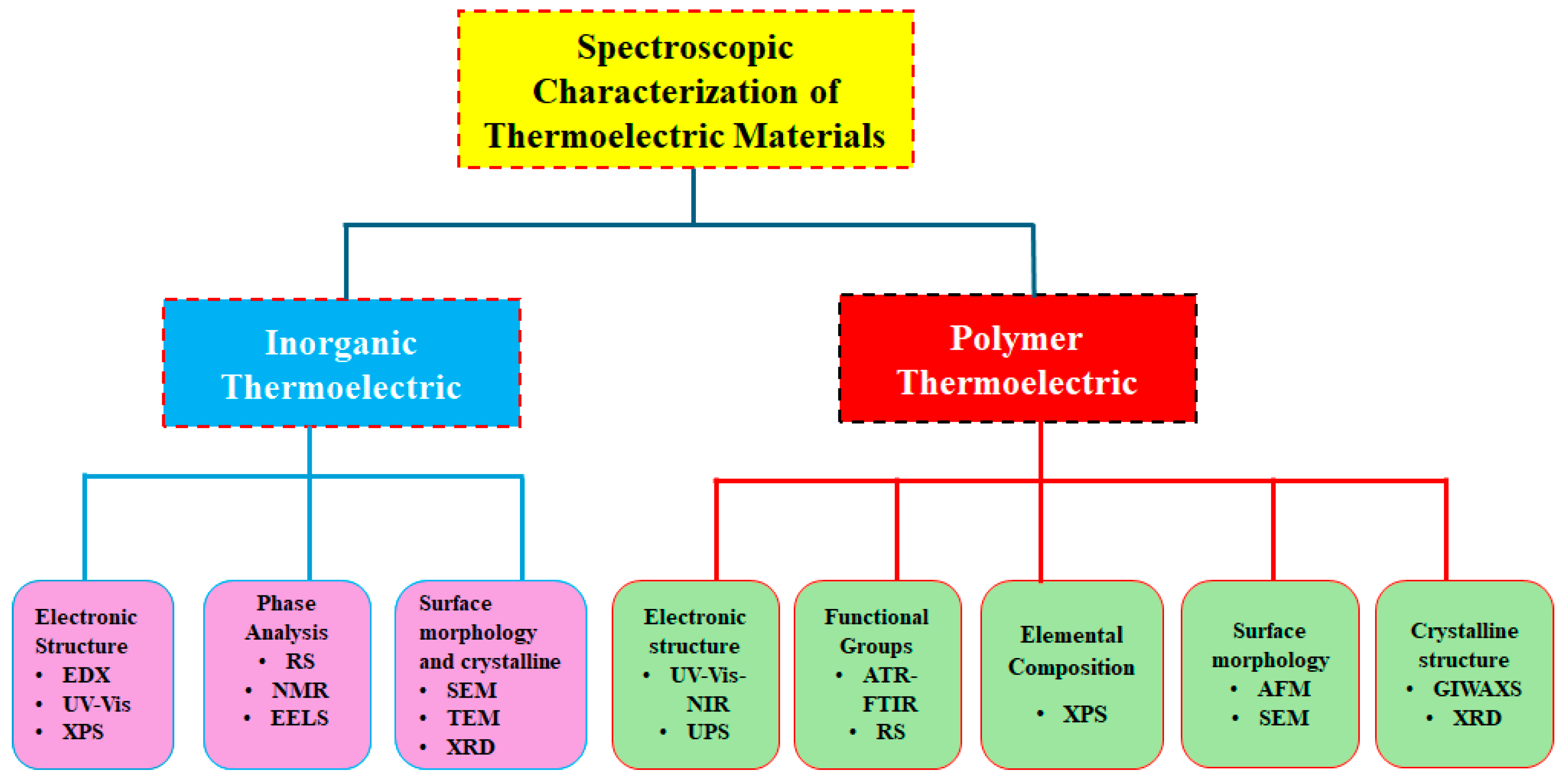
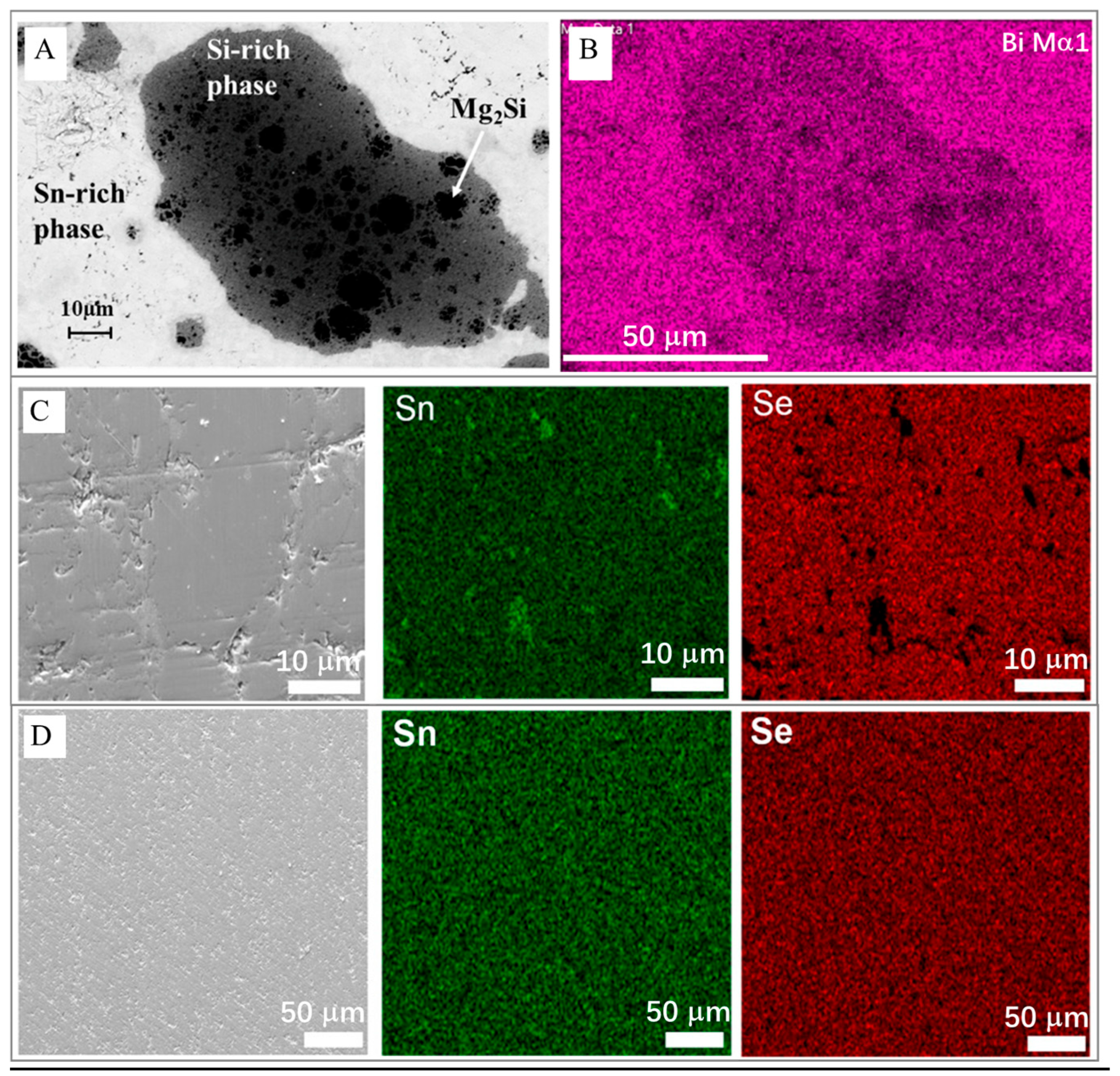
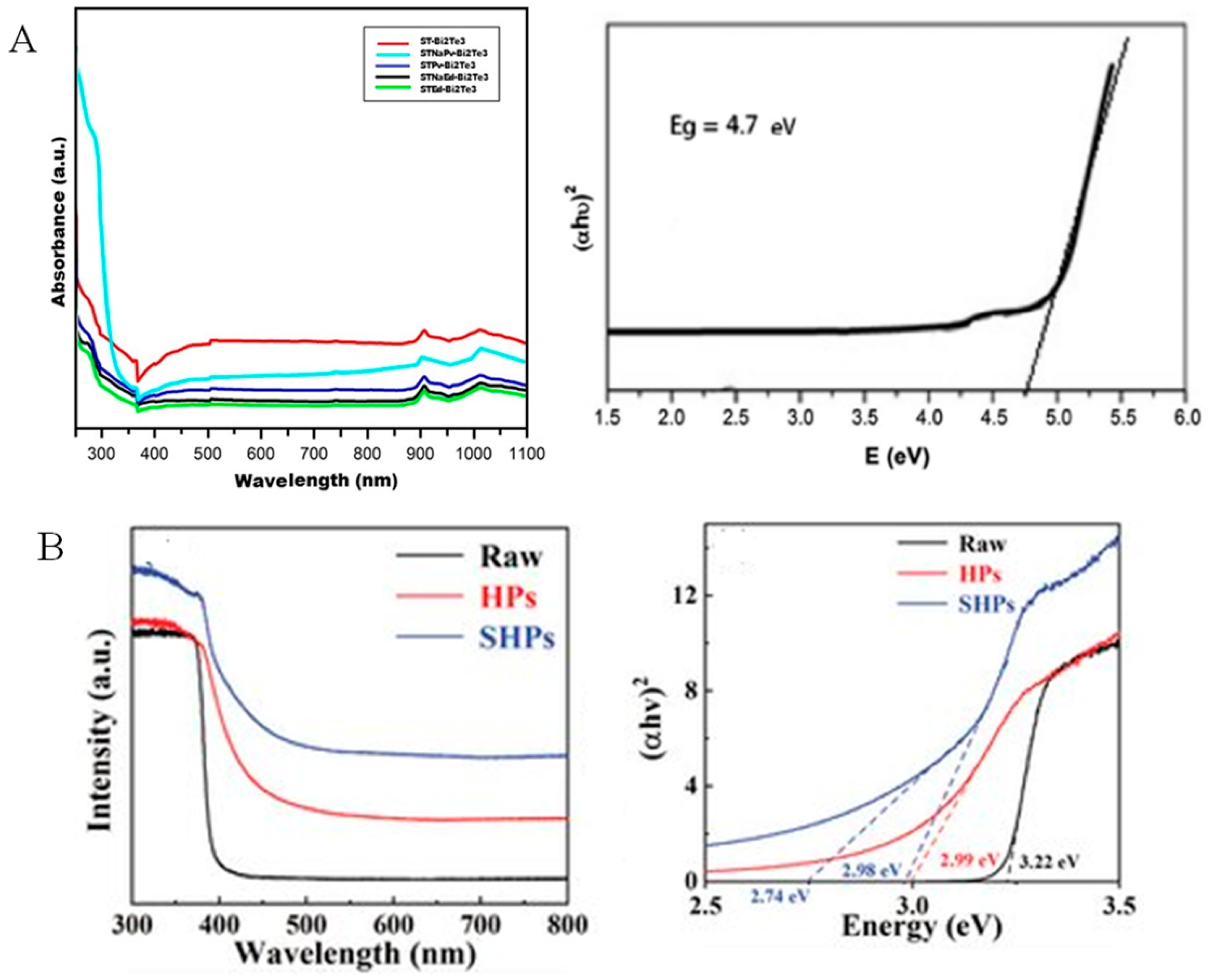
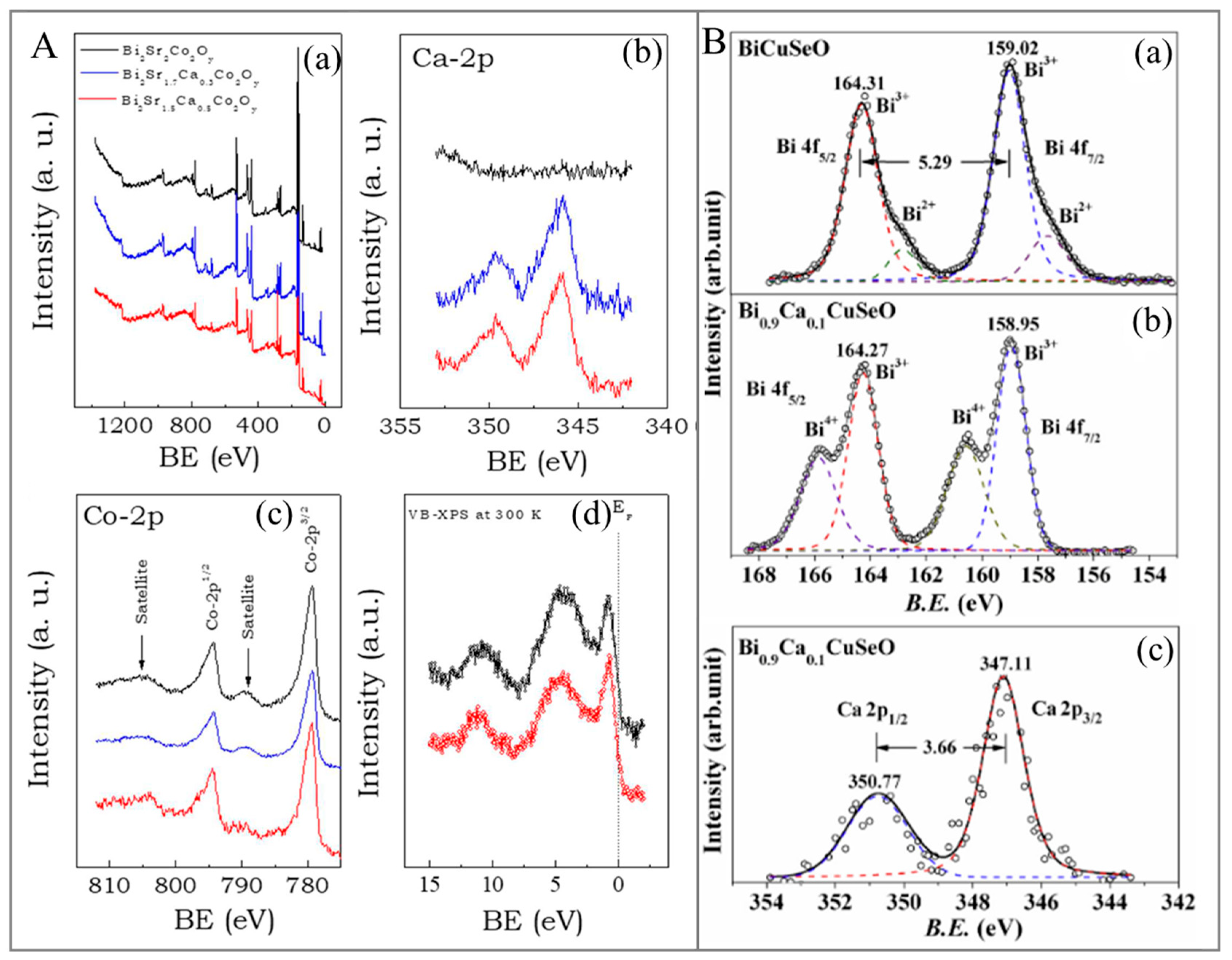

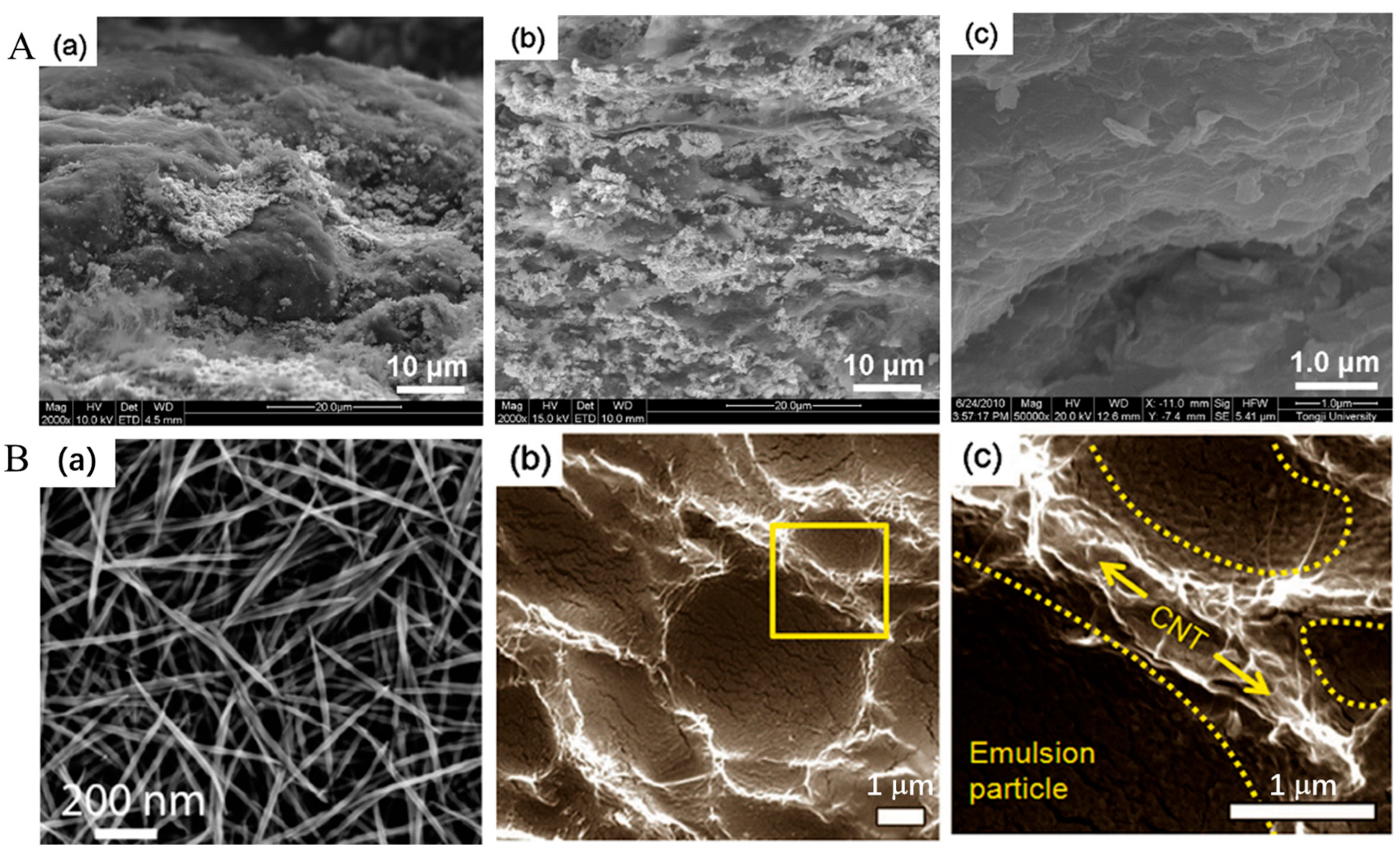

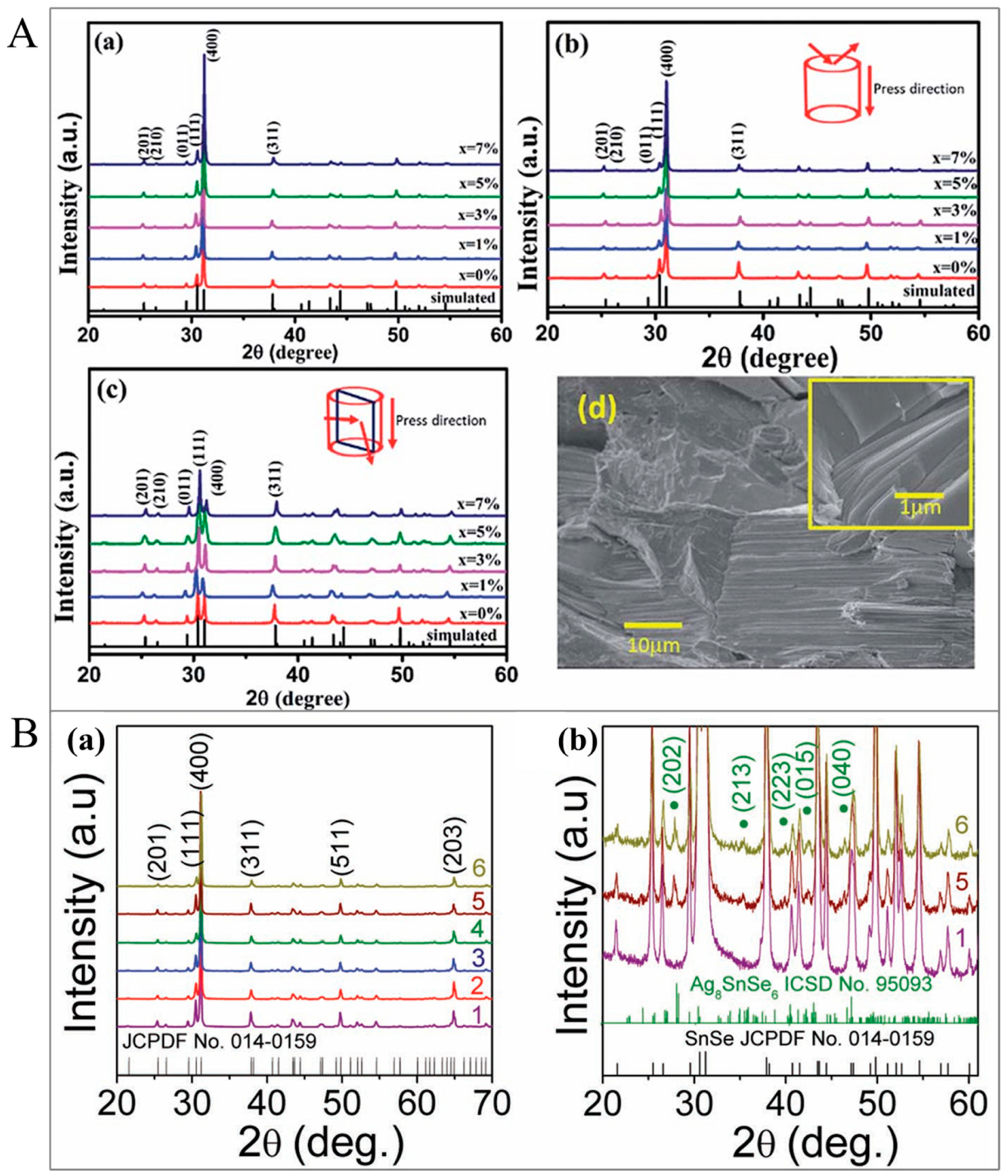
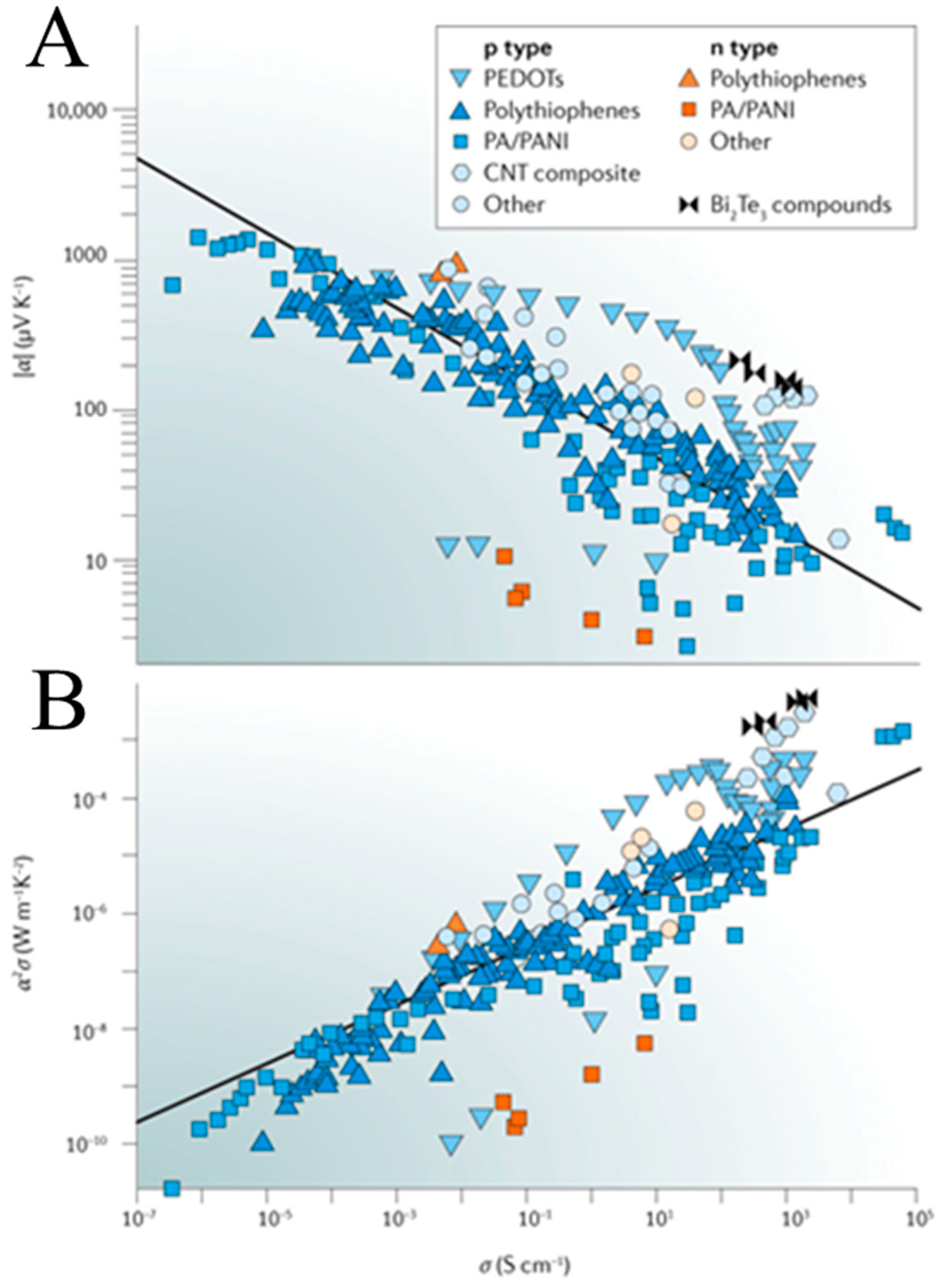
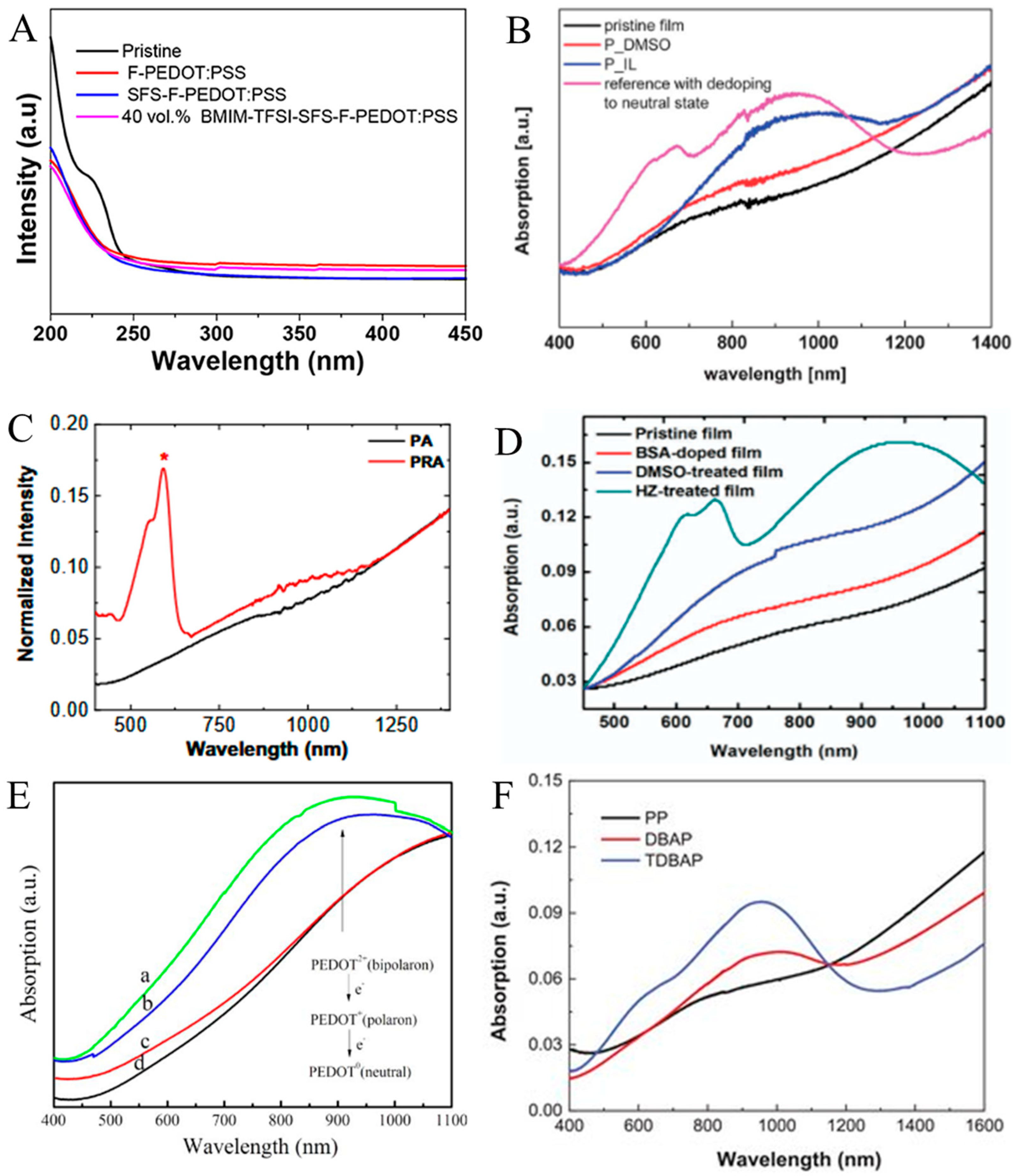
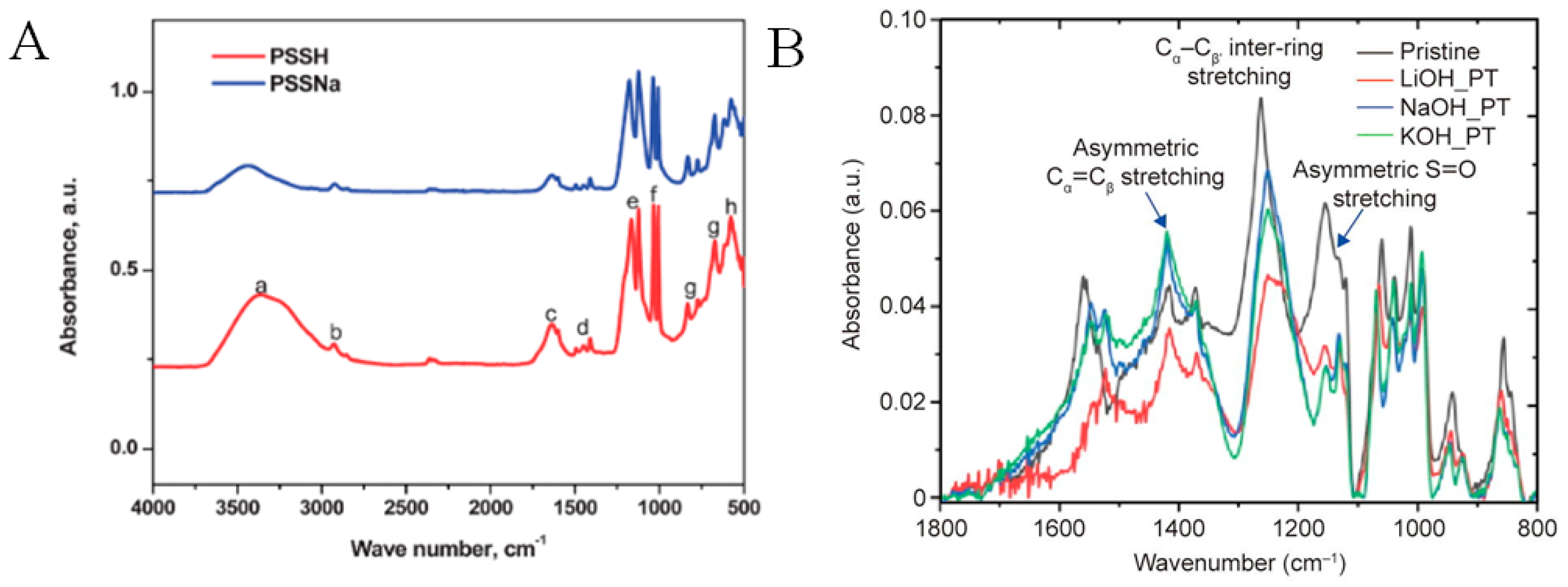

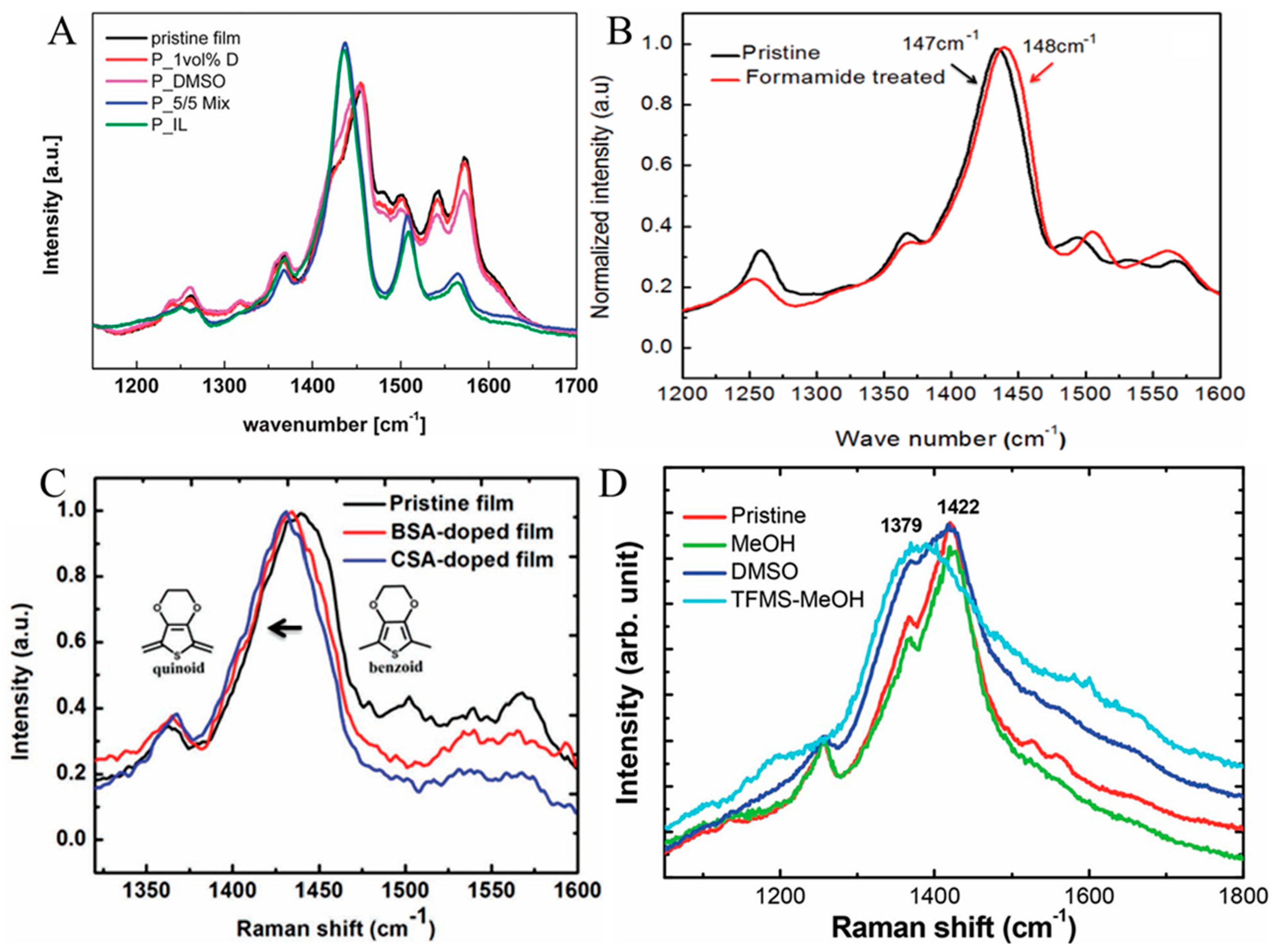
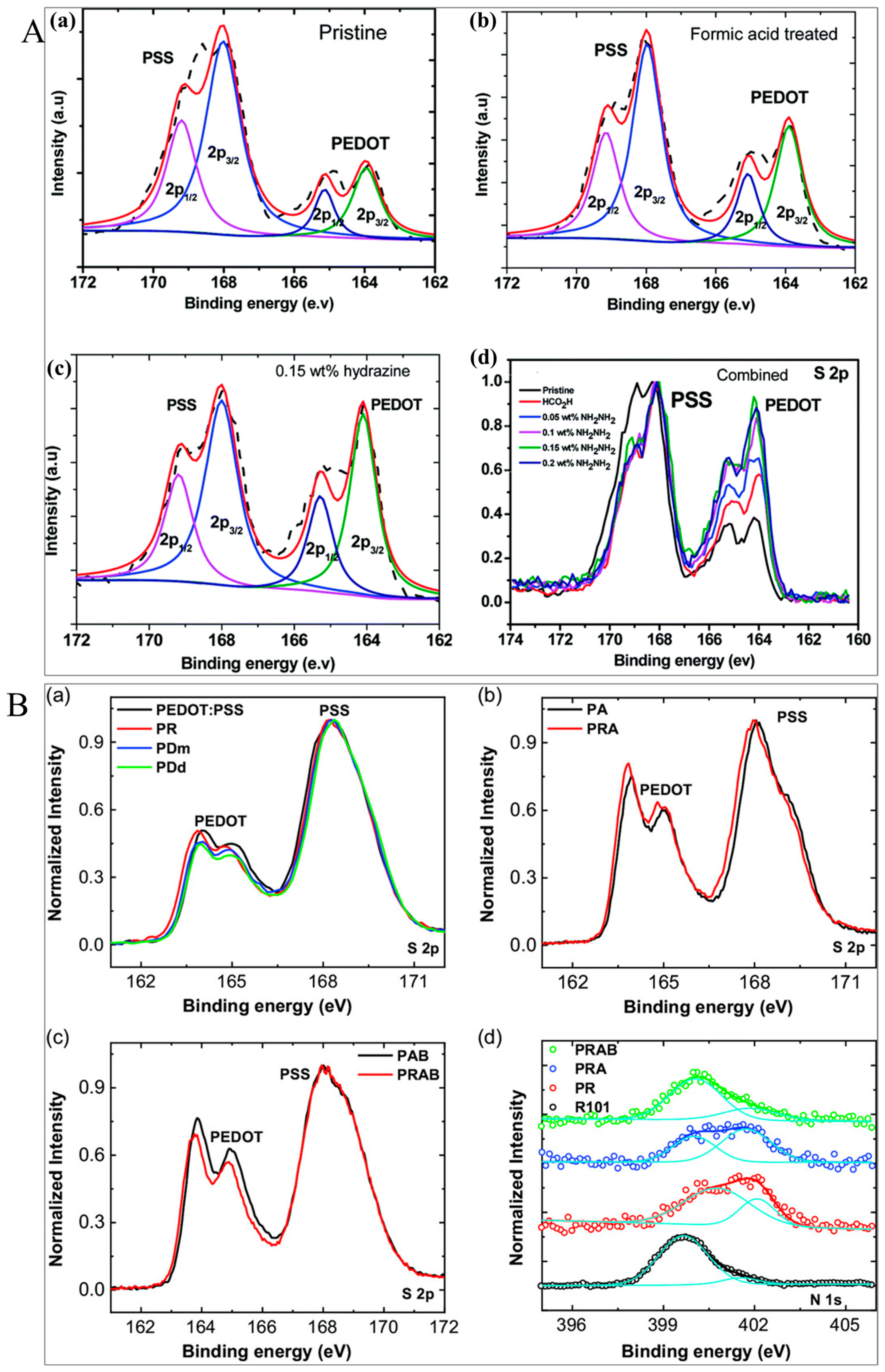
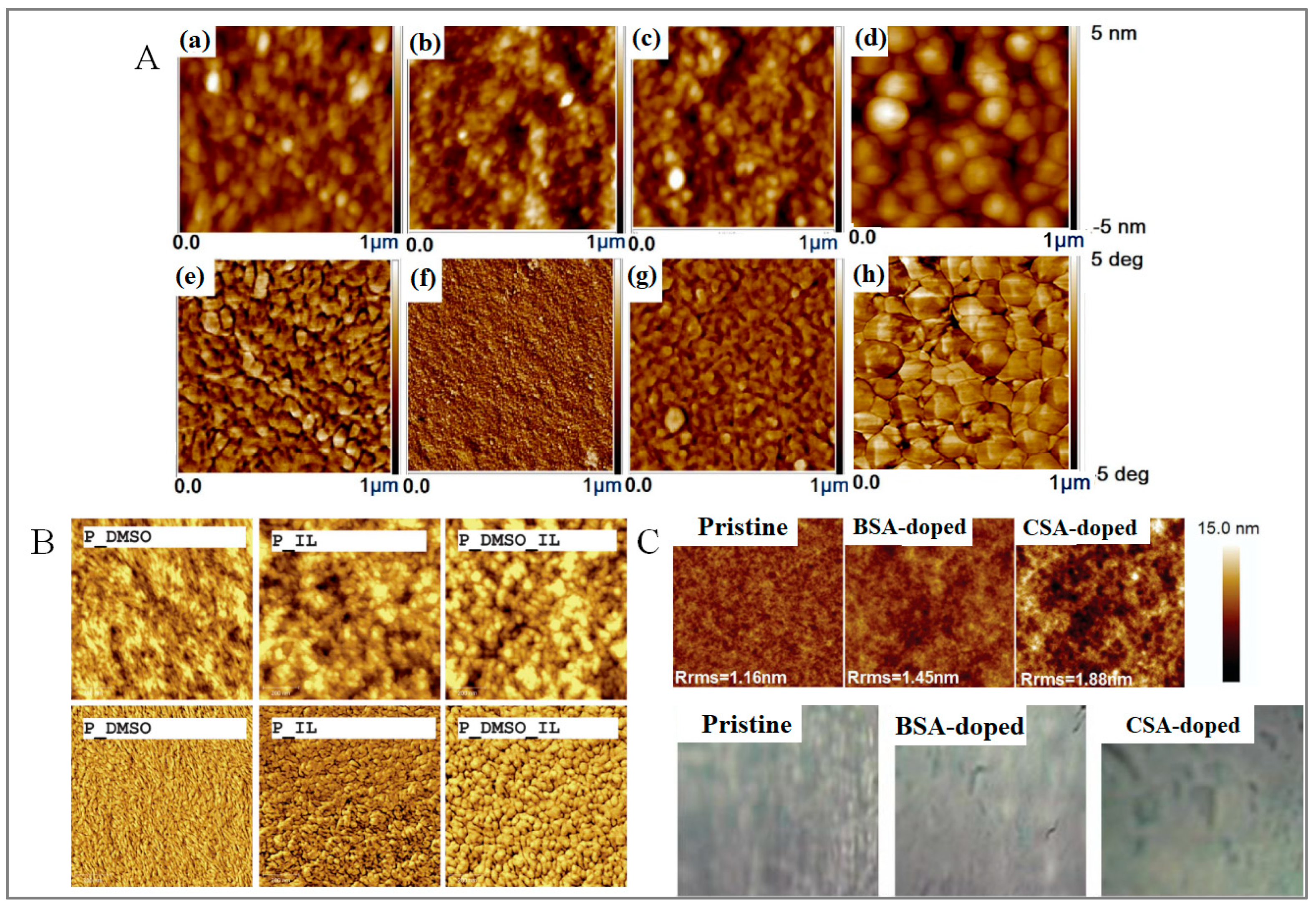
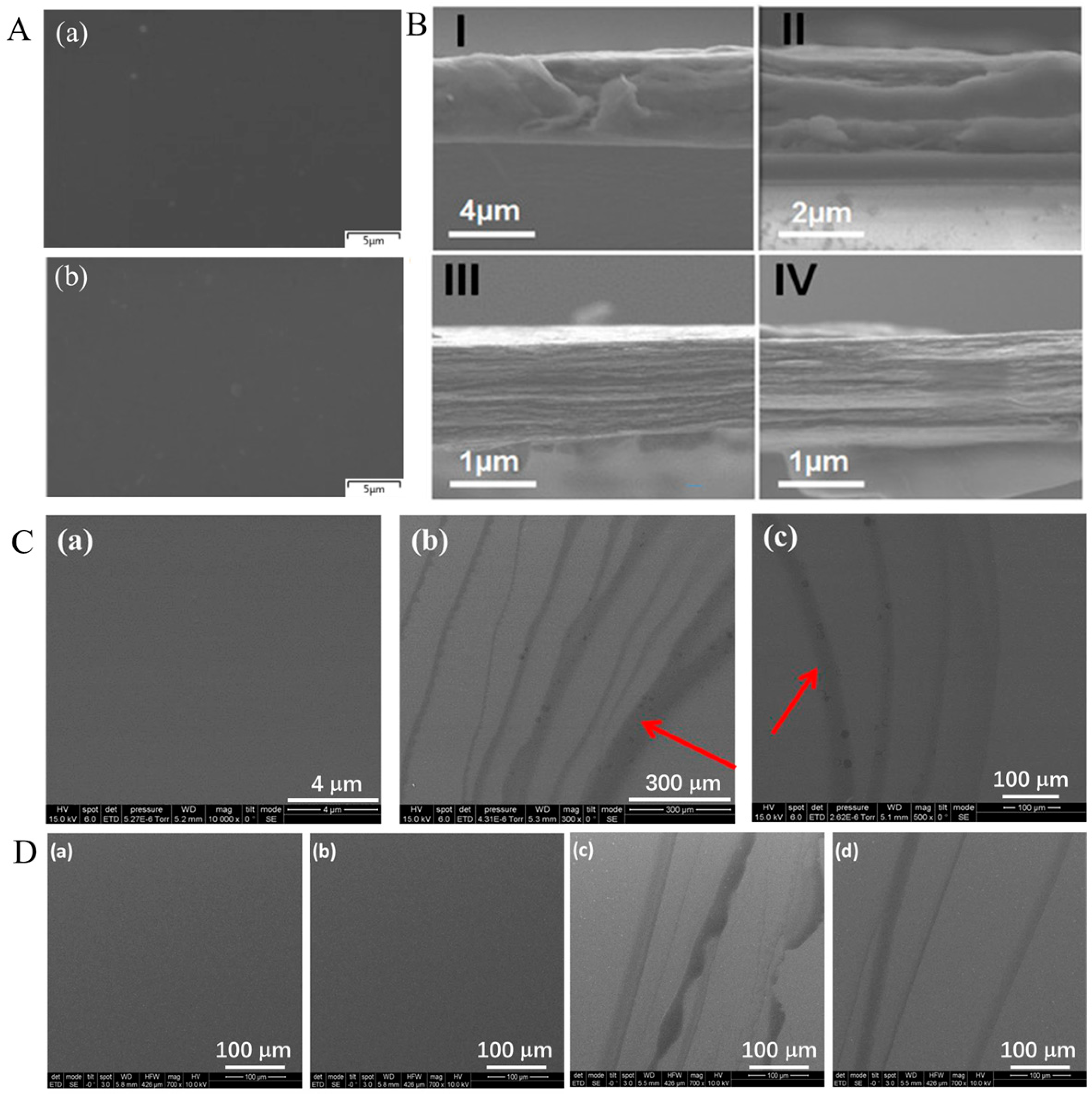
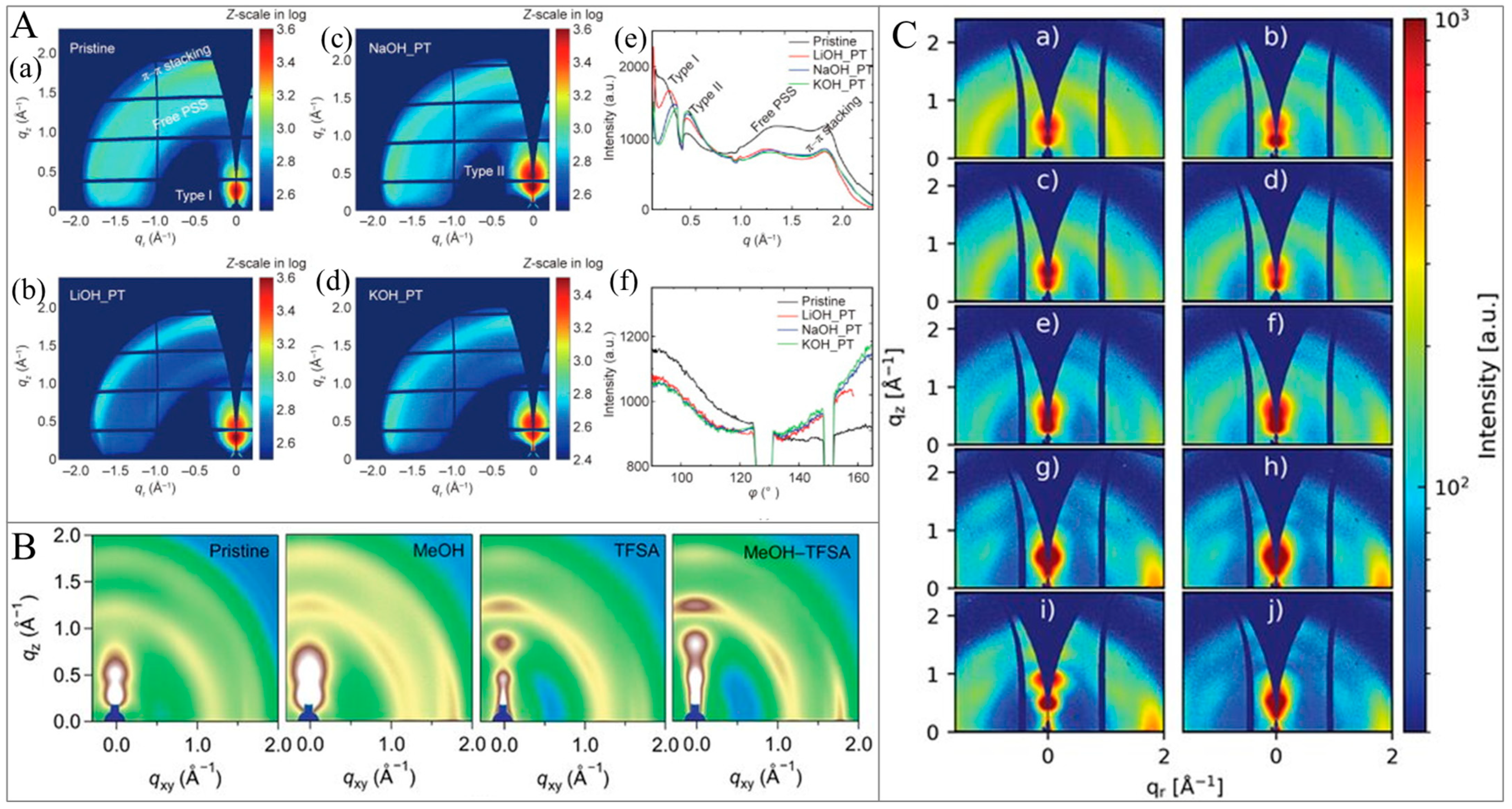
Disclaimer/Publisher’s Note: The statements, opinions and data contained in all publications are solely those of the individual author(s) and contributor(s) and not of MDPI and/or the editor(s). MDPI and/or the editor(s) disclaim responsibility for any injury to people or property resulting from any ideas, methods, instructions or products referred to in the content. |
© 2025 by the authors. Licensee MDPI, Basel, Switzerland. This article is an open access article distributed under the terms and conditions of the Creative Commons Attribution (CC BY) license (https://creativecommons.org/licenses/by/4.0/).
Share and Cite
Yemata, T.A.; Wubieneh, T.A.; Zheng, Y.; Chin, W.S.; Tadsual, M.K.; Beyene, T.G. Spectroscopic and Microscopic Characterization of Inorganic and Polymer Thermoelectric Materials: A Review. Spectrosc. J. 2025, 3, 24. https://doi.org/10.3390/spectroscj3040024
Yemata TA, Wubieneh TA, Zheng Y, Chin WS, Tadsual MK, Beyene TG. Spectroscopic and Microscopic Characterization of Inorganic and Polymer Thermoelectric Materials: A Review. Spectroscopy Journal. 2025; 3(4):24. https://doi.org/10.3390/spectroscj3040024
Chicago/Turabian StyleYemata, Temesgen Atnafu, Tessera Alemneh Wubieneh, Yun Zheng, Wee Shong Chin, Messele Kassaw Tadsual, and Tadisso Gesessee Beyene. 2025. "Spectroscopic and Microscopic Characterization of Inorganic and Polymer Thermoelectric Materials: A Review" Spectroscopy Journal 3, no. 4: 24. https://doi.org/10.3390/spectroscj3040024
APA StyleYemata, T. A., Wubieneh, T. A., Zheng, Y., Chin, W. S., Tadsual, M. K., & Beyene, T. G. (2025). Spectroscopic and Microscopic Characterization of Inorganic and Polymer Thermoelectric Materials: A Review. Spectroscopy Journal, 3(4), 24. https://doi.org/10.3390/spectroscj3040024










